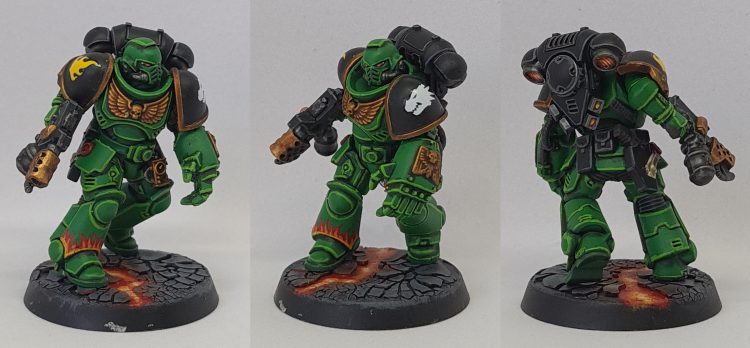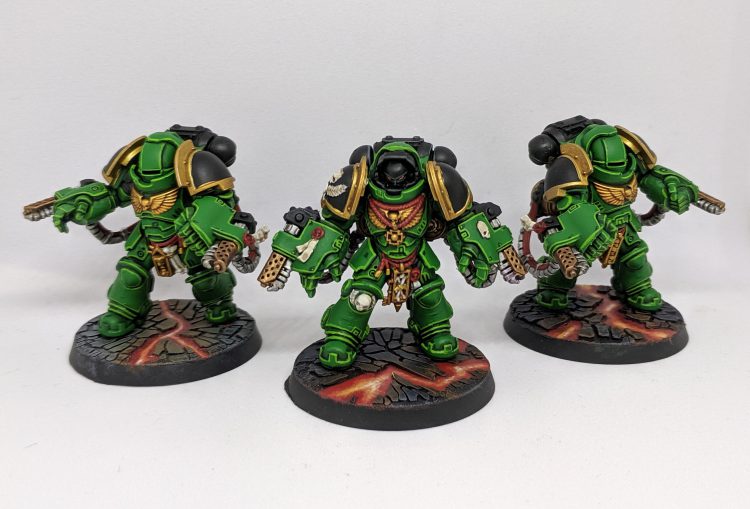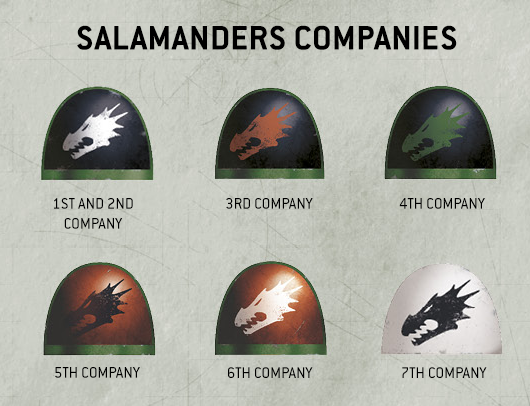This article is part of a larger series on how to paint Space Marines. To return to that series, click here.
In our How to Paint Everything series, we take a look at how to paint well, everything, with a look at different methods from different artists. In this article we’re looking at the XVIIIth legion of space marines, the Salamanders.
The Salamanders are one of the original 20 Legions of Space Marines, warriors whose origins stretch back as far as the era of the Great Crusade. Originally known as the Dragon Warriors, the Salamanders were renamed after being reunited with their Primarch, Vulkan. Although the Salamanders fought honourably throughout the Great Crusade, their main role in the Heresy was being on the receiving end of the Isstvan Dropsite Massacre along with the Iron Hands and Raven Guard. Few Salamanders survived the massacre, and Vulkan himself disappeared in the chaos.
It turns out Vulkan had been captured and was subsequently tortured by Night Haunter before being taken to the Imperium Secundus where John Grammaticus attempted to resurrect him. Initially this was thought to have failed, but eventually, the Primarch was revived on Nocturne. From there the Salamanders’ main participation in the rest of the Heresy was acting as a guerilla force, striking back against the brothers who had betrayed them.
Following the end of the Heresy they were able to seamlessly reform themselves as a Chapter without splitting the Legion, supposedly because there were too few Salamanders left to exceed the manpower restrictions of the Codex Astartes. As a result there were no official Salamanders successors, although the Storm Giants and Black Dragons are rumored to utilize their geneseed. The Salamanders have taken part in some of the best-known actions of the 41st Millennium, including the Second and Third Wars for Armageddon where they fought with distinction (and in the latter case, they were one of the Chapters which received special rules in the Codex: Armageddon campaign book), as well as the cleansing of the Ymgarl moons where Genestealers were first encountered, and the Badab War.
The Salamanders are unique among marine chapters in that they seem to be much more closely connected to humanity than other Space Marine Chapters. Unlike those Chapters which occupy remote fortress-monasteries in hostile terrain, emerging only to select new recruits, the Salamanders have an official base on the moon of Nocturne, Prometheus, but when not on campaign most brothers spend their time living in the villages from which they were recruited.
As a faction, Salamanders feature a mix of interesting elements and styles, from green armor to flame designs painted on it, heat scarring on melta weapons and flamers, heraldry, and scales and salamander pelts.
Covered in this Article
- Techniques for painting the core elements of the Salamanders, including their classic green armor, flame designs, and heat scarring from melta weapons.
- Schemes from different painters for how to paint the Salamanders, including the chapter’s Pre-Heresy look.
- Notes on the heraldry and iconography of the Salamanders.
Salamanders Heraldry - Click to Expand In the modern 40k setting, the Salamanders are unusual in that they are formed of seven companies (reflecting the tribes of Nocturne) rather than the ten dictated by the Codex Astartes. Similarly, the Salamanders do not change their trim colors by company and instead vary the color of their chapter icon and shoulder pad, with red and green icons for the third and fourth companies, black for the fifth and seventh, and white icons for the first, second, and sixth companies. Red fields are used for the fifth and sixth company shoulder pads (these are the reserve companies). These companies are composed of 12-13 squads each. Salamanders have a fairly unique scheme as 40k armies go. They’re green with black pauldrons, but it’s a very different, brighter green than the Dark Angels. Their Chapter symbol is cool and relatively easy to freehand if you’re feeling up to it, or of course there’s the Salamanders upgrade sprue pictured above. They also have a lot of scope for cool flame details and conversions to wear drakeskin cloaks – the old Dark Elf Cold One Knights are a good source of appropriate materials. The Salamanders are also notable for being the only prominently black Chapter, although what kind of black has fluctuated across their history, and GW now seem to have settled on “yeah no they’re black like literally coal-black daemons with scary red eyes” which is a bit of a shame. Below, we have a number of different painting styles appropriate for Salamanders, which you can choose to follow or use to inspire your own take on the XVIIIth Legion. Flames - Click to Expand One prominent aspect of the Salamanders is their use of flame and melta weapons in battle. They often paint flame designs on their armor as well, and this can add some interesting challenge to painting Salamanders models. Rockfish: For the flames I don’t really go for fancy super realistic or very cartoony, I think these end up somewhere in the middle and also being pretty fast. I don’t really go for any shape in particular but I find it is pretty key to have a few floating embers or it looks really lame. I start with a couple of layers for the underlying red, but you can get away with a single coat for the rest as blotchy-ness in lower layers just leads to subtle colour variations in the final design. Whiteshark12: I struggle with creating good shapes for the flames on the fly so I can’t provide much input there, but I’m happy with the colour palette i’ve chosen. Start with painting an outline of the flames in Mephiston Red. I start from the tip and bring it downwards in a wavy motion. Connect these flame tongues together towards the base. Then paint concentrically smaller flames with Wild Rider Red and Fire Dragon Bright, then finally underline with a layer of Yriel Yellow. https://youtu.be/b5UyWTHyDks?t=1063 An alternate style I plan to try some day. Heat Staining - Click to Expand If you’re painting a Salamanders army, chances are good you’ll be painting a lot of melta weapons and flamers and that means you’re going to want to paint heat staining on the barrels of those weapons. You can find our guide to painting Heat Staining in our How to Paint Everything – Battle Damage article. Skin Tones - click to Expand The Salamanders canonically have had darker skin, though whether this is merely standard darkly-pigmented skin for humans or the more recent coal black tone is up for some interpretation. Official materials give the chapter’s marines coal black skin with red eyes, giving them a bit of a demonic look. Which look you want to go with is up to you. Rockfish: I’m not super fond of the old lore of having salamanders be all coal black-skinned demonic looking dudes as there have been some problematic bits of that, so my tendency is to instead have my marines have a slight ashen complexion over top a convectional skin tone and red eyes. I usually start by using a base coat that looks a like a normal skin tone, say catachan flesh, knight questor, bugmans, or any other colour humans might be then wash it in targor rageshade (perhaps a questionable name for the colour GW hmm?) and then highlight by mixing administratum grey into the base coat from before. The eyes are just whatever red I think fits, usually mephiston or khorne though. There’s a million ways to do skin for salamanders, and I am not entirely comfortable with this one as it can sometimes compress the range of tones from a distance, so I am sure I will come back and iterate on this again! PierreTheMime: Basecoat of Abaddon Black Lighten large surface areas gradually with a blending of Abaddon and a white/off-white Eyes are dotted with Wazdakka Red Wash of Agrax Earthshade Edges/top surfaces get another lightened coat/drybrush depending on the surface Small dot of Evil Sunz Scarlet on the eyes. Whiteshark12: The easiest way to paint the weird charcoal skin of Salamanders is to not have any skin exposed. Thank you for your time, I will not be taking questions. Molten Weapons - click to Expand Rockfish: This is way less effort then the first impression you get of the final product. Start with a base coat of tau light ochre then layer a bit of ungor towards the center you can do a mixed transition but I find you can often get away without it. That’s because I do a sequence of glazes of gryph-hound straight from the pot towards the edges, essentially just layered one atop each other in narrower bands before drybrushing/stippling on the black at the edges. Rockfish's Current Method - click to Expand Salamanders are my second largest army after Tyranids and my scheme has gone through quite a number of iterations. I’ve kind of lost track of how many times I have iterated upon my salamanders scheme – the number is possibly close to ten now – and eventually it just made sense to update the method for the new version of our How to Paint Salamanders article. Getting into the thick of things I start with a airbrushed zenithal green over the models, I quite like the definition this gives and also offers some effort saving. Priming black is probably the lowest effort colour to prime as there are a million different ones that all work great, then going over that with a wide-angle zenithal of nocturne green it gives a bit of a transition and a base for the worst colour in the entire scheme. Warpstone glow is just objectively a terrible colour that only mad people (IE me) use as the main part of a scheme, even through the airbrush I find this will take 4-8 coats to look good and never thins quite how I want it to. After the airbrush booth comes the conventional brushwork, and something you will probably immediately notice is that even a character like this only has five different colours as the post green basecoats. This is primarily because I am lazy. The other answer is that washes and highlight colours will do more then enough to differentiate the different materials, particularly with how most marine units are actually surprisingly limited in how many different textures are used. Most can be broken down into the following based in my scheme: There are a few other details here, which are covered below and in other sections of this article. The washes are mostly straightforward, but you will find that I love using contrasts on metals to give them a kind of saturation that they really benefit from, in this case I use snake bite on the gold and basilicanum on the steel. Otherwise the next weird choice I have is to use drakenhof to recess shade the green as it can read as darker and more itegrated then something like nuln oil due to fun colour theory stuff I only vaguely grasp in a intuitive way. I think the others should be pretty logical, parchment gets washed sepia, the cloaks with extremely thinned agrax, and finally the seals get painted in with shyish. After that we get into the highlights, and I recommend starting with the blue/black as its the easiest to clean up after at this stage. The recipe for it is pretty simple but does glaze in the transition of thunderhawk, you can do mixes and its fine too thought! The edge highlights and shoulder pad recess lines are just conventional line highlights of russ and fenrisian grey. Once that highlight is out of the way the rest of the scheme goes by quick, this cloak was probably the most time consuming single thing remaining as its glazed up with baneblade brown intentionally using a small brush to add the texture organically. The rest are just conventional layer highlights, the green armor has a couple of slightly interesting choices of elysian green and zamasi desert for the highlights to shift towards yellow remaining saturated without getting florescent or cartoony like moot would. The metals are both share a final highlight colour that gets mixed gradually into the main highlight in the form of stormhost silver, then respectively the steel gets revisited with the base coat of iron hands while the gold gets highlighted with liberator gold. The parchment is glazed or layered depending on the size of the area with flayed one flesh and the seals get a area highlight of warpfiend and slaanesh grey, those could be glazed or transitioned in but usually they are small enough that you can get away with just the one coat of each. Next up is the details! The simplest is using wyld wood to sketch in the text on the parchment, I often get the inconsistency of written text by moving my brush in the opposite way to what would be comfortable. IE if I normally pull the brush towards myself to draw a straight line, I would draw it away and get a bit of organicly shaped text with a minimum of effort, though I would suggest adding sentence breaks by lifting off intentionally! The eye lenses follow the typical style for doing lenses and have a reasonably simple set of colours too. I start with khorne red as the base, then add a single layer each of wazdakka, wild rider, fire dragon and flash gitz working towards the brightest point. Sometimes on a bigger lense I will add a transition mix between each colour but you can get away without that on a surprising number of things. Next up for the reflection I use a simple white to draw it in, its worth mentioning that I use the same basic recipe for screens and targeting laser just replacing the white reflection with flash gitz! I have a couple of ways of doing the flames, the first is the simple way where I start by sketching in the first few shapes in a coat of Mephiston then the rest of the colours are just progressively smaller rough ‘c’ shapes of evil suns, fire dragon, ungor, and pallid wych. Placing the little ‘c’ shapes in various directions gets the idea across enough while still keeping it down to a minute or two a model total, but for centerpieces or characters I’ll draw in the distinct flames carefully and add transitional mixes wherever I feel it is too stark. In this case the model has a plasma which follows my standard blue plasma colours, base coat baharroth, wash thinned ultramarines contrast then use thicker coats of it to shade the ‘cool’ areas of the coils. Then just build in the brightest bits by slowly mixing white into the base coat until you use just the slightest touch of pure white. Apply any transfers you want to, then move on to the base which I mostly like to keep simple, apply a coat of vallejo grey sand then paint everything other then shell cases in zandri dust that gets drowned in sepia once dry. You can leave things there but I like to both knock down the sand to something more realistic and tie the model into it by carefully airbrushing a thin layer of vallejo model air yellow brown to just apply a filter to the lowest parts of the model. After varnishing the last steps are painting the rim and tossing clusters of plants on, for these I use Gamers Grass Burned 6mm, Beige 4mm, Dry 6mm, and Brown 4mm. This is keeping things really basic, start with grey seer wash it apothecary white then highlight with ulthuan grey while gradually mixing in white. Also nice and simple here, start with zandri dust wash it with thinned agrax earthshade then glaze in highlights with ushabti bone. The lights start with morghast bone, then I paint them in as lenses using screaming skull slowly getting white mixed into it. The tracks are nice and simple too, coat them in cygor brown then heavily drybrush them with zandri dust then tie them into the desert with the filter of yellow brown. I just apply a coat of flesh terrors red over the metal and then drybrush it with the metal highlights, absolutely dead simple! Rockfish's Older Method - Click to Expand This method is from an older version of this article, but still contains a helpful alternative method for achieving very similar results. While in a bit more logical order than my Death Guard scheme, I will apologize in advance for my tendency to bounce between different colours as this guide is in chronological order. In addition, I will mostly not list the specific colours in the accompanying text as that can get pretty repetitive and a bit redundant with the paints being in the pictures themselves, instead I am mostly going to be talking about why I made a colour choice. I started with a airbrush base coat of Warpstone over Nocturne, this is roughly a zenithal basecoat since I only focused the Warpstone on upper faces of the model. This is not super visible from most viewing angles, but speeds up the pin wash substantially as the darkest areas are already shaded. For the wash I used blue rather than a black to provide a slightly more natural shade. In proper colour theory, one way you can darken a colour is by mixing toward the “bottom” of the colour wheel with blue in this case. Of course that is just one method, you can also shade by working in a complementary colour for warmer shadows. I quite like how Basilicanum Grey is basically super Nuln Oil, achieving the same kind of colour smoother and darker. An additional layer of Fyreslayer makes a delightful copper-ish colour. I nicked the idea for black metal for Salamanders from the Bladeguard that was shown off on Warhammer Community to prevent from having the gold being overbearing as was happening on previous iterations. A recent change for me is making use of more drybrushing in stuff like metals instead of intermediate edge highlights, which saves a bunch of time without a substantial loss in quality. I used to be super against drybrushing, but these days the extra effort just not worth it given I can get a greater differentiation of metals vs other textures with less time. The gold is mostly pretty typical other then the using contrast to get a really rich colour along with a dry brush of Liberator, I quite like how it turned out! I made use of contrast over a dark-ish base coat to get a rich dark red for the tassels, this is one of the ways you can really get a lot more colours out of contrast paints, don’t lock yourself to Wraithbone and Grey Seer! One thing that might be a touch confusing here is that the Agrax and Sepia was used for the cables and bone/parchment respectively. I go with these basic layered zenithal highlights on the black primarily for sanity’s sake, on the table top a lot of stuff like that ends up looking nice and smooth when amongst others and the terrain without having to spend a ton of time on fancy blends. The Agrax was used on the bone to give it a slightly more muted colour along with the dryad bark. I quite like Apothecary White as it gives a decent neutral color over white but you could use pretty much any wash thinned over white depending on what you want to go for. We will come back to finish the iconography off in a bit once the wash has dried! For the yellow cables I started with a brown base coat to provide a really stark contrast against the highlighted sections, otherwise I find cables can look like they have not even been highlighted from a distance. We return to finish off the iconography! I somewhat violate the my typical behavior of only doing zenithal highlights on these as I want to put a lot of emphasis on the depth of the dragon’s face. For this I put the brightest points on stuff like the jaw, brows, and spines that should be be bold against the rest really to emphasize the key parts of the Salamanders logo. For the flames I don’t really go for fancy super realistic or very cartoony, I think these end up somewhere in the middle and also being pretty fast. I don’t really go for any shape in particular but I find it is pretty key to have a few floating embers or it looks really lame. I start with a couple of layers for the underlying red, but you can get away with a single coat for the rest as blotchy-ness in lower layers just leads to subtle colour variations in the final design. For the eye lenses I do a fairly traditional gem effect. For those who have not done gems before, the general idea is to subdivide the lense into smaller crescent shaped areas of successively brighter colours towards one direction before a final point of white on the opposite point. Usually you select a lower or further into an object for the crescents of colours to imply light shining through and reflecting off the inside of the gem/lense. While optional, I came back to put a few edge highlights on the black to differentiate the smooth curves from hard edges. Then we return to the green after not having touched it since the recess shade, I left the main panels to end as this lets you hide mistakes from other colours under thicc highlights. The yellow in the highlights is also calling back to basic colour theory where we move successively brighter shades of a colour towards the top of the colour wheel, typically the only colour you can highlight with white without losing saturation is yellow. My bases on smaller models is typically fairly basic, just wash and drybrush over a texture paint before cleaning up the rims and throwing on tufts from Gamers’ Grass. I am still unsure my exact strategy for how I am going to handle the skin tone going forward, when I have figured it out I will probably come back and drop in another section somewhere down here. My current plan is probably doing more conventional human skin tones glazed with a ashen grey or similar. PierreTheMime's Method - Click to Expand I attempt to follow a pretty traditional color scheme for Salamanders, though there’s a few variations due to personal color preferences. My painting method uses a minimal set of paints and is decently fast to All models are painted using standard brushes and primed black, which gives the colors a dark and natural feel. Basecoat of Warpstone Glow Wash of Agrax Earthshade Touch up large surfaces and ridges/details with additional layers of Warpstone Glow until they reach a smooth and bright appearance Edge highlight with a 4/1 mix of Warpstone Glow and Wraithbone. This gives the highlights a bit of a muted color tone, but it looks pretty decent on the table. You could certainly opt to highlight with a brighter green such as Moot Green or its equivalent Perform touchups of Agrax in areas that may have caught some paint or need to be darkened Basecoat of Abaddon Black Lighten large surface areas gradually with a blending of Abaddon and a white/off-white Eyes are dotted with Wazdakka Red Wash of Agrax Earthshade Edges/top surfaces get another lightened coat/drybrush depending on the surface Small dot of Evil Sunz Scarlet on the eyes Basecoat of Balor Brown, wash of Agrax, touchups of Balor, highlight of 3:1 Balor and Wraithbone Basecoat of 2:1 mix of Abaddon Black and White Scar. Multiple layers on raised surfaces, gradually increasing the white Using a large dry-brush, dot even-lighter paint on to give the cloak a textured concrete look Wash of Agrax Earthshade, making sure to not let the wash pool in the recesses Basecost of Leadbelcher Paint gun plates with selected color choice (I used black for normal bolt weapons and red for “heavy” bolt equivalents). Wash of Agrax Earthshade Edge highlights of brighter plate colors Whiteshark12's Method - click to expand I tend to lean heavily into sharp edge highlighting and strong colours which result in a vibrant scheme that looks striking on the tabletop. This is definitely labour intensive and takes a fair few hours for each model, so I wouldn’t try this for a horde army, but I’ve been building my Primaris force slowly enough that it’s not an issue. By far my biggest tip, which applies to any miniature painting, is to get a high quality brush and a wet palette. A good brush (I use near-exclusively a Kolinsky Sable #1 brush) is able to hold a fine point for a long time, and a wet palette lets you control the consistency of your paint for extended lengths of time by countering evaporation. I remember watching this video (https://youtu.be/VbAUFTXA13M) when I first started painting and thinking it was black magic, which is an excellent example of someone with a quality brush, good brush control, and impeccable dilution of their paint. If you want to get at every part of a model then subassemblies are the only way to go. I try to keep subassemblies to a minimum, usually keeping the arms seperate from the body so the chest eagle is accessible, and anything that is entirely a different colour such as the backpack. I glue each subassembly to a length of sprue, secured somewhere out of the way like on the sole of a foot or inside the shoulder. This pairs well with using an airbrush to prime rather than a rattlecan as you can spray each subassembly individually without wasting much primer. First I prime each subassembly with vallejo black primer, then undercoat with VMA Black-Green (this is a holdover from when I basecoated with a brush and used to use GW Waaagh Flesh). Next I undercoat the green parts with airbrushed Warpstone Glow. This produces a beautiful green, but goddamn Warpstone Glow has atrocious coverage and is probably the worst paint i’ve ever airbrushed. One of the times I’ve been most disappointed in the last 12 months was looking through the new range of GW airbrush paints and seeing Warpstone Glow missing from the list. If you plan on airbrushing, be sure to keep some flow improver ready to fine tune the consistency, and keep an eye out for dry tip. This is the stage where many people create beautiful zenithal layers, but I’ve never had much luck with this paint. Shading is done with a pin wash of Nuln Oil directly into all recesses, keeping it fairly narrow but heavy – i’ve found tapping the brush along rather than painting a single stroke is a good way to get a heavy coat with precision. I also undercoat in brushed on VMA Black any parts which won’t be green and I don’t trust to not pick up some underlying hues, such as the gold chest eagle. The edge highlighting is the cornerstone of the scheme here, so take your time, use a good brush, and make sure that your consistency is good (hence the wet palette recommendation). You’re looking to make sure every line of nuln oil is bounded on at least one side by some Moot Green. Soft parts of the armour are based with VMC Basalt Grey, then heavily washed with Nuln Oil. The purity seal is based with VMC Ivory then lightly washed with Agrax Earthshade. Having tried many different recipes for dark gold, one of the best looking i’ve found is deceptively simple. I start with a smooth base layer of Retributor Armour, then add a single very heavy coat of Agrax Earthshade. While i’m sure better results could be achieved with a 12 step NMM approach, this does a bloody good job for little effort. Vallejo airbrush metallics are fantastic, even when brushed on. VMA Gunmetal has completely replaced Leadbelcher for me, though the watery consistency can take a moment to get used to. I’ve used VMA Aluminium in the past as a bright silver which has perfect coverage, but it’s a hair too bright for my tastes. The easiest way to paint the weird charcoal skin of Salamanders is to not have any skin exposed. Thank you for your time, I will not be taking questions. I struggle with creating good shapes for the flames on the fly so I can’t provide much input there, but I’m happy with the colour palette i’ve chosen. Start with painting an outline of the flames in Mephiston Red. I start from the tip and bring it downwards in a wavy motion. Connect these flame tongues together towards the base. Then paint concentrically smaller flames with Wild Rider Red and Fire Dragon Bright, then finally underline with a layer of Yriel Yellow. https://youtu.be/b5UyWTHyDks?t=1063 An alternate style I plan to try some day I like to add a heat haze to my exhausts to make them look like they’re kicking out loads of heat, and it adds some colour to an otherwise boring black/dark steel section. From here on the colour series gets smaller like a bullseye “The eyes are the window to the soul” is a cliche quote but it’s not far off the truth, and remains true for miniature painting. I start with painting the lens with Mephiston Red, then wash it lightly with nuln oil to pick out the rim. I add a small amount of Fire Dragon Bright towards the inside, then very carefully add a dot of white at the back of the lens. The finished model: You can find me on instagram under @cowiepaints_402 if you have any comments or want to see more green dudes. The Salamanders are a storied faction, and one that’s a ton of fun to paint. In addition to having lots of melta weapons and flamers, their striking color scheme affords opportunities to try new things and mix it up. Whether you’re painting older veterans, or fresh novices, there’s a ton here experiment with. Have any questions or feedback? drop us a note in the comments below. Or contact us at contact@goonhammer.com. This article is part of a larger series on how to paint Space Marines. To return to that series, click here. Salamanders units do not use the same battlefield role notation as other chapters, using flames to mark their battle and reserve companies on the right shoulder pad. Salamanders use gothic script to denote squad number.
Salamanders units do not use the same battlefield role notation as other chapters, using flames to mark their battle and reserve companies on the right shoulder pad. Salamanders use gothic script to denote squad number.
Painting Salamanders
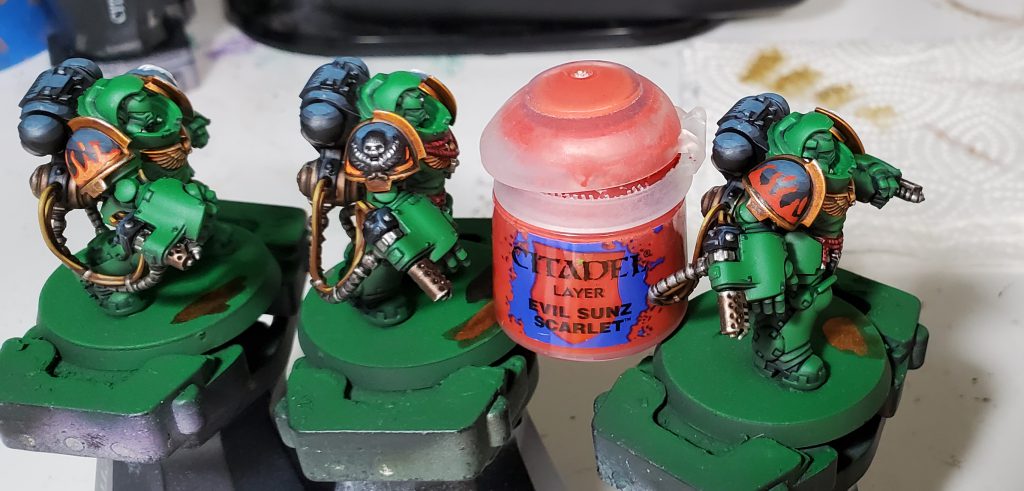
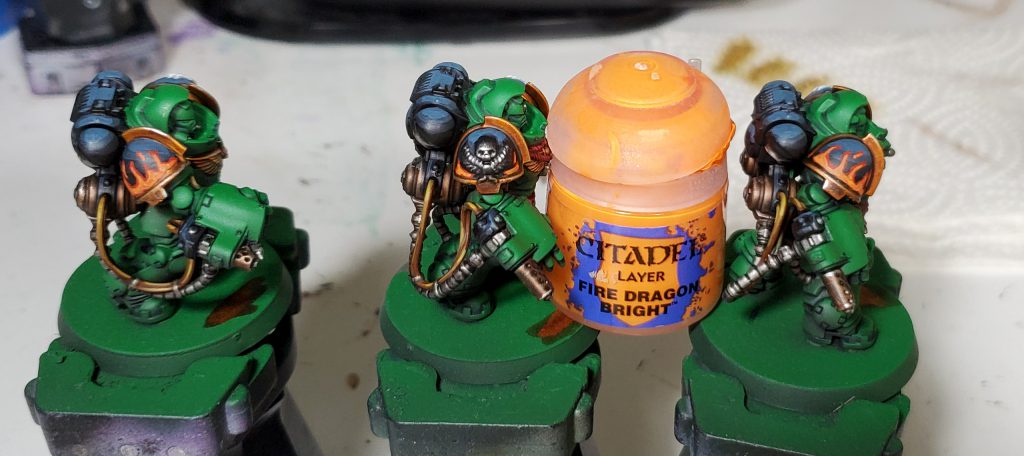
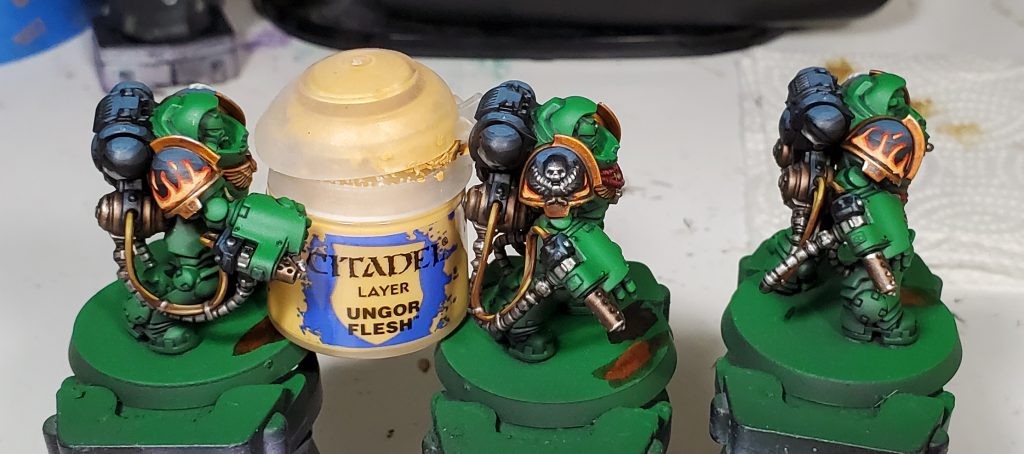

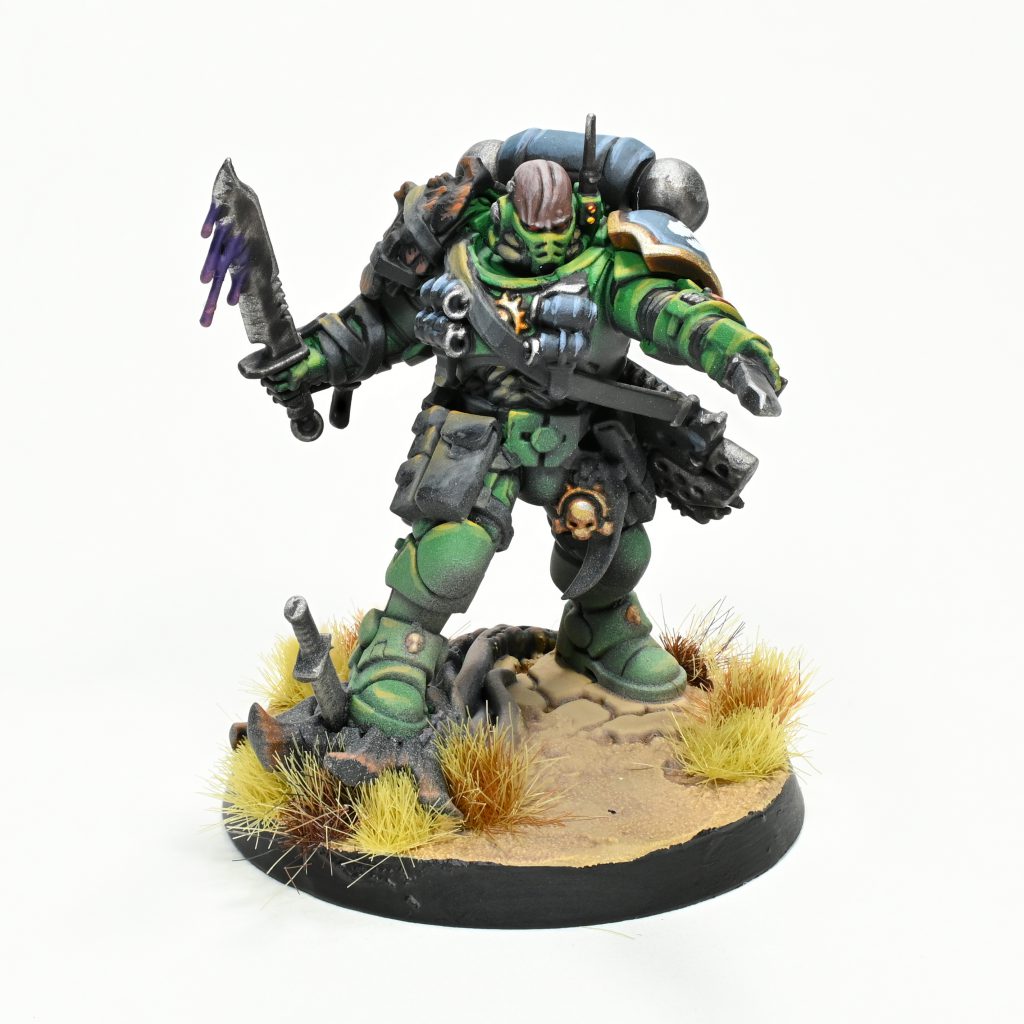
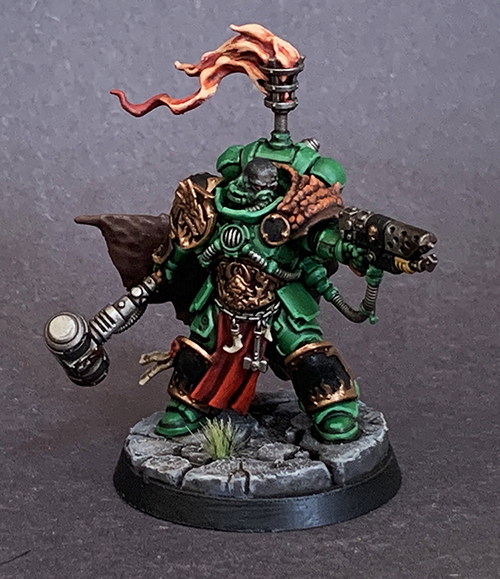
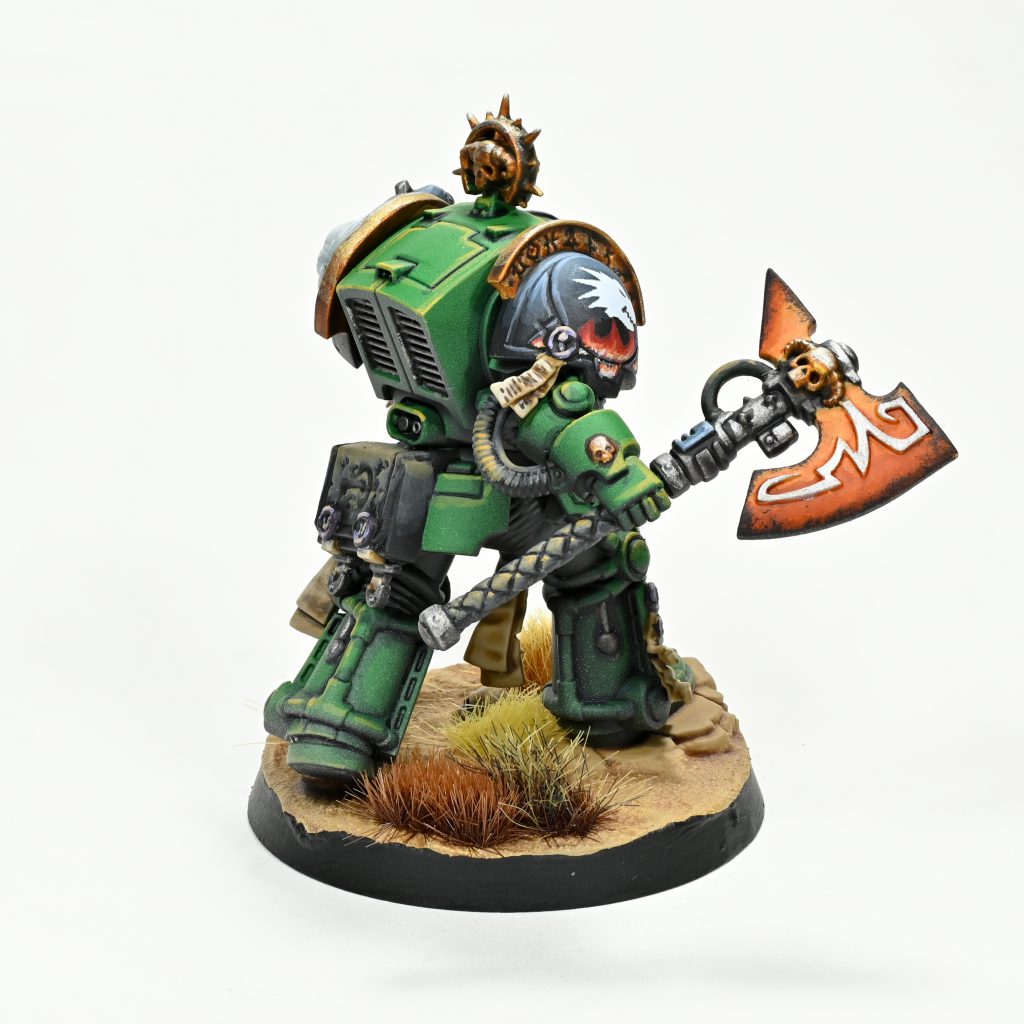


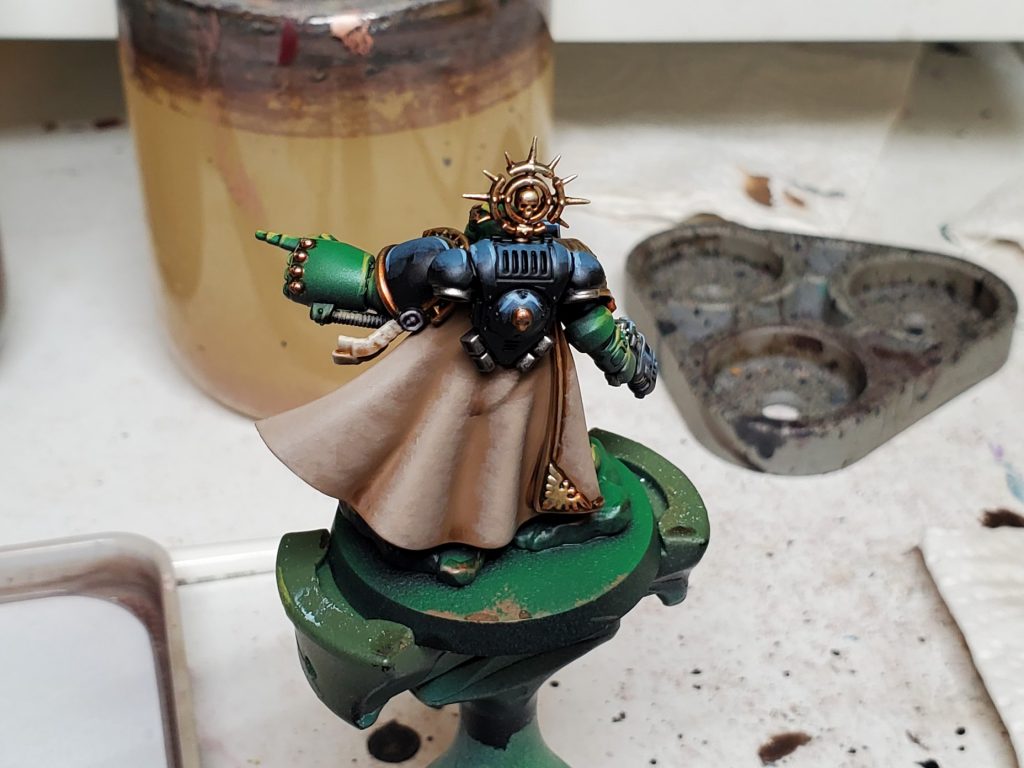
 The non armor black gets differentiated from armor by using warm highlights of stormvermin that gets a bit of tau light ochre mixed in for each increasingly bright highlight. It adds a bit of a organic or rubbery texture to the black that I think helps split it off pretty well, but you could of course start with a grey as a basecoat for further differentiation.
The non armor black gets differentiated from armor by using warm highlights of stormvermin that gets a bit of tau light ochre mixed in for each increasingly bright highlight. It adds a bit of a organic or rubbery texture to the black that I think helps split it off pretty well, but you could of course start with a grey as a basecoat for further differentiation.

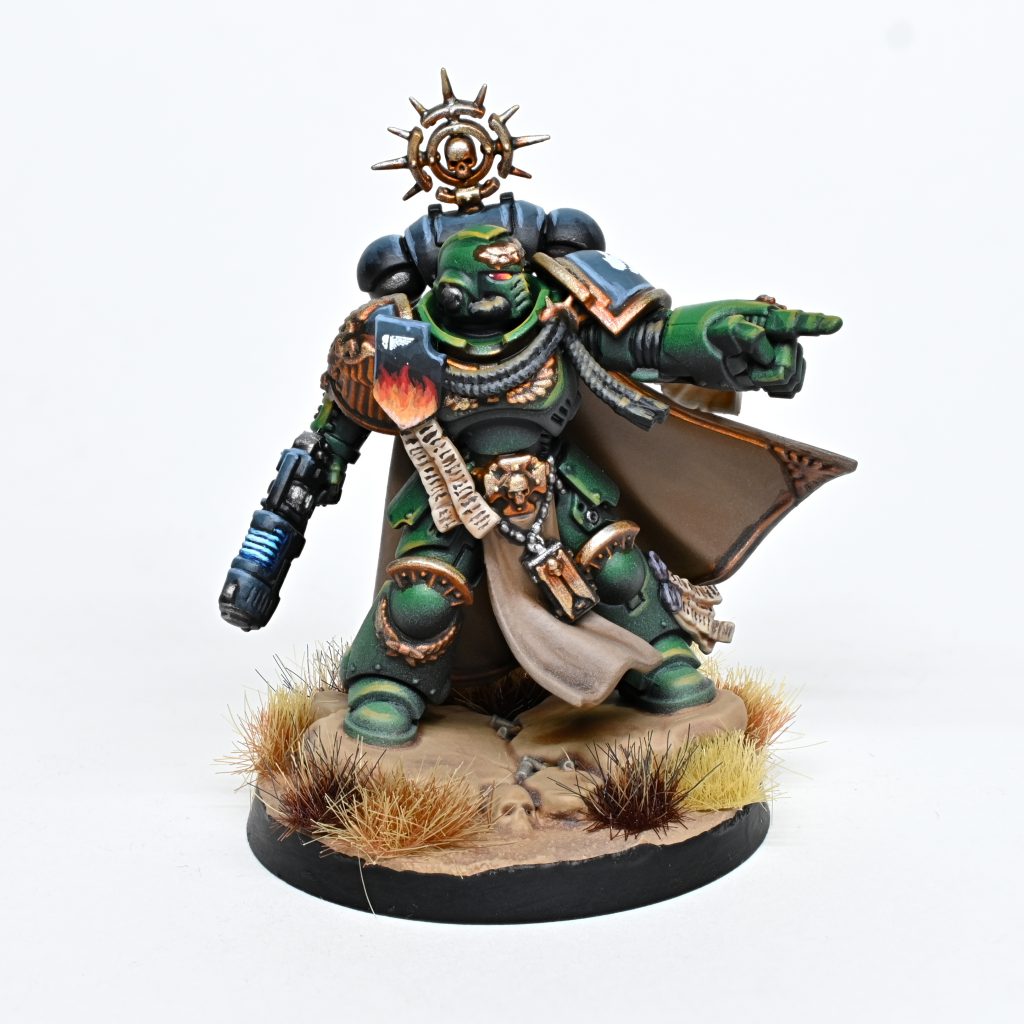
White/Stone Iconography
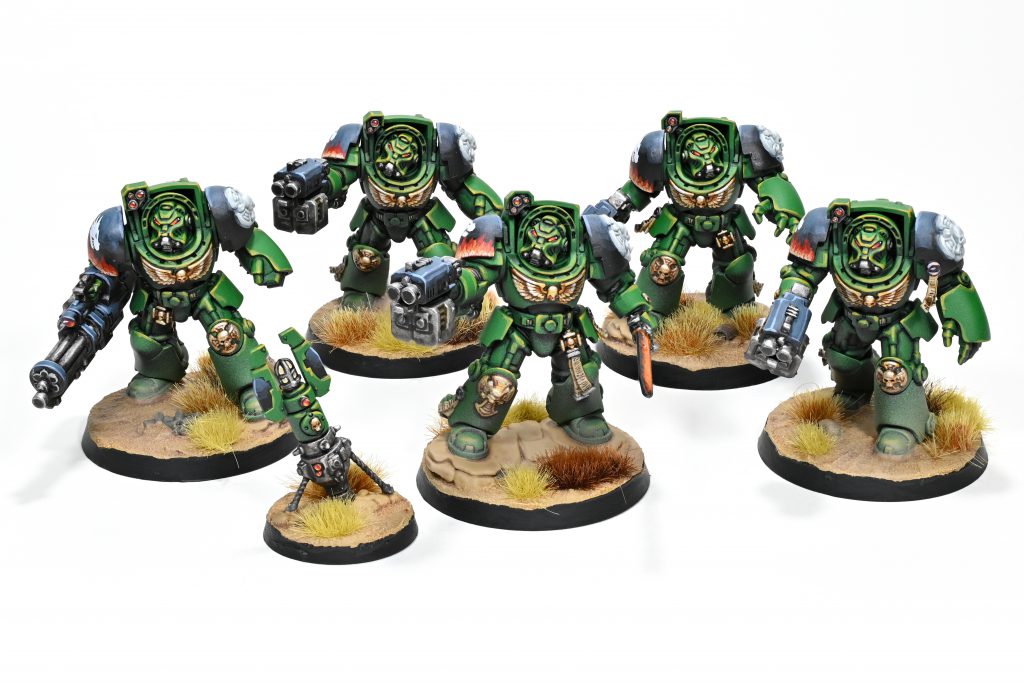
Bone
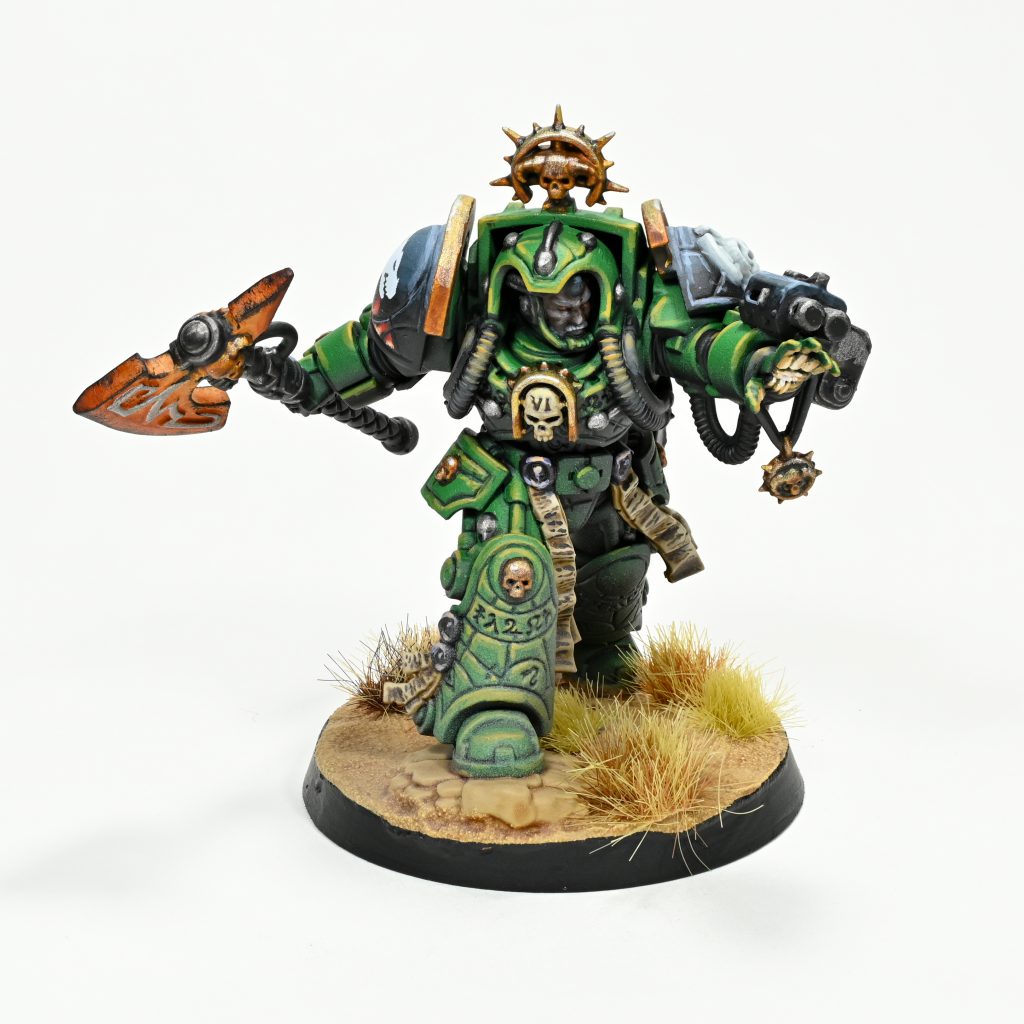
Vehicle Lights and Tracks
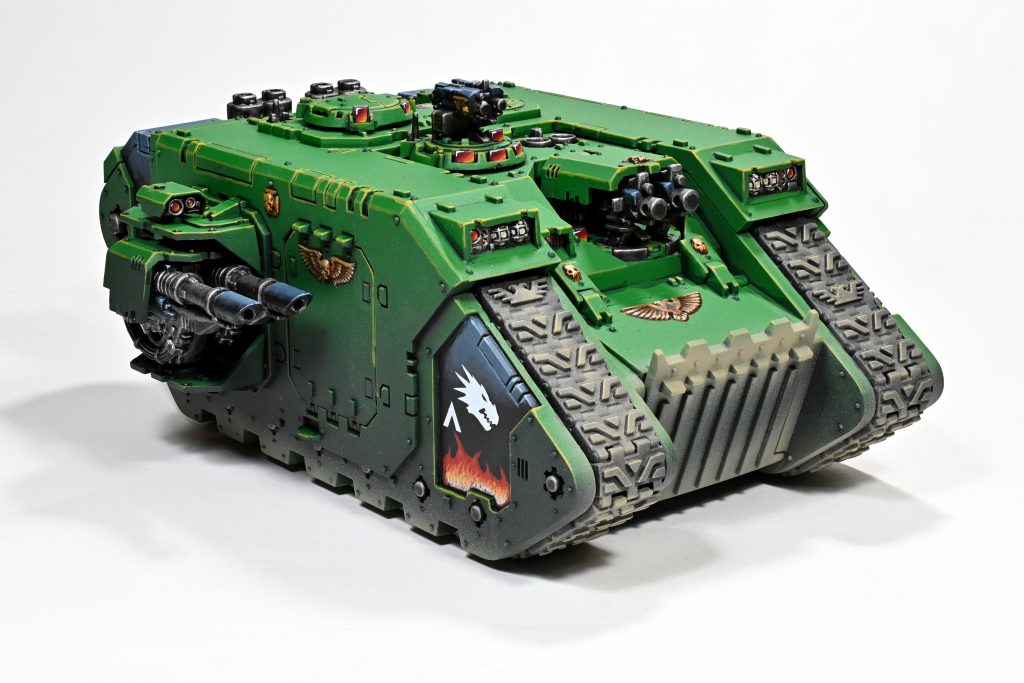
Missiles

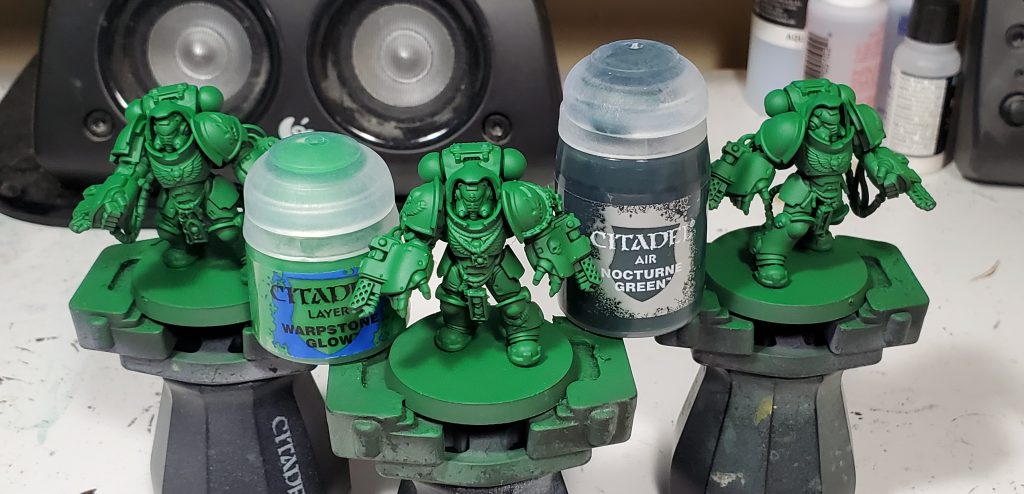

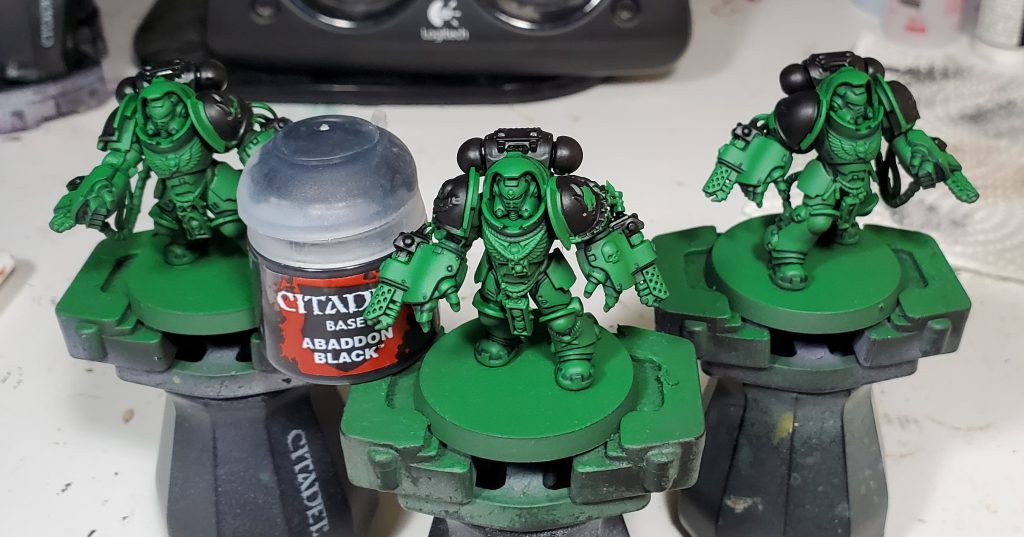
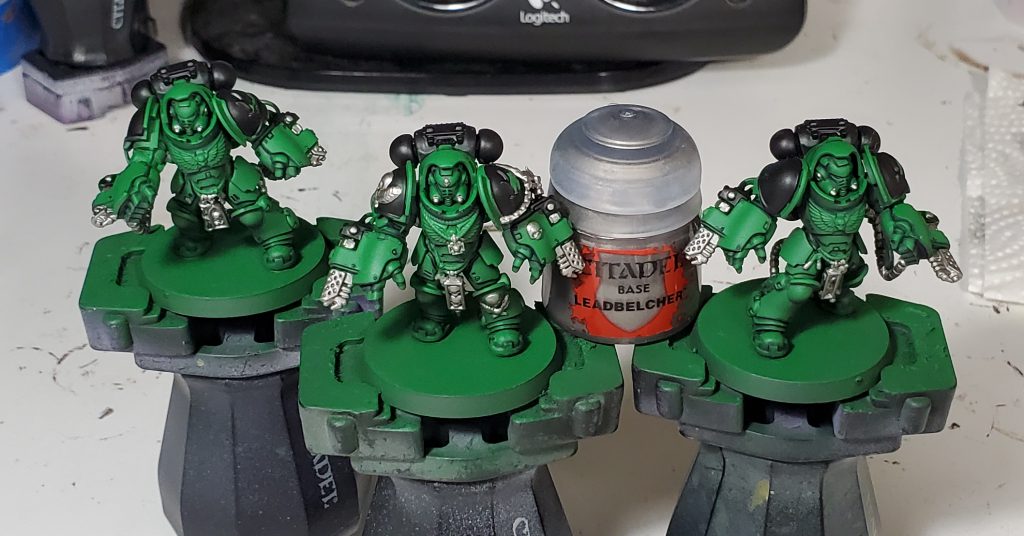
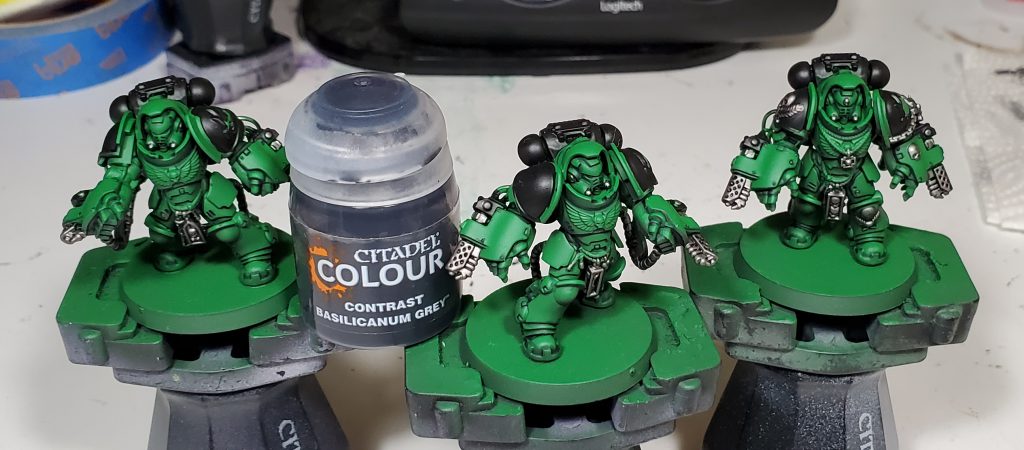
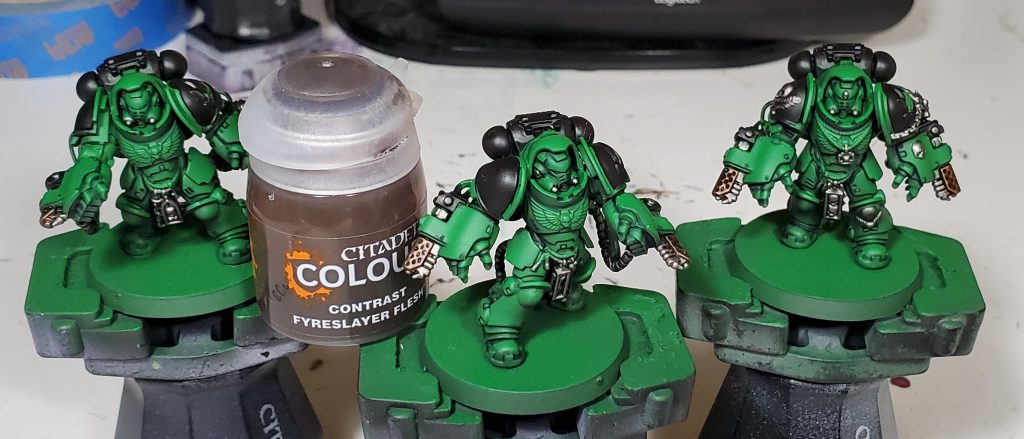
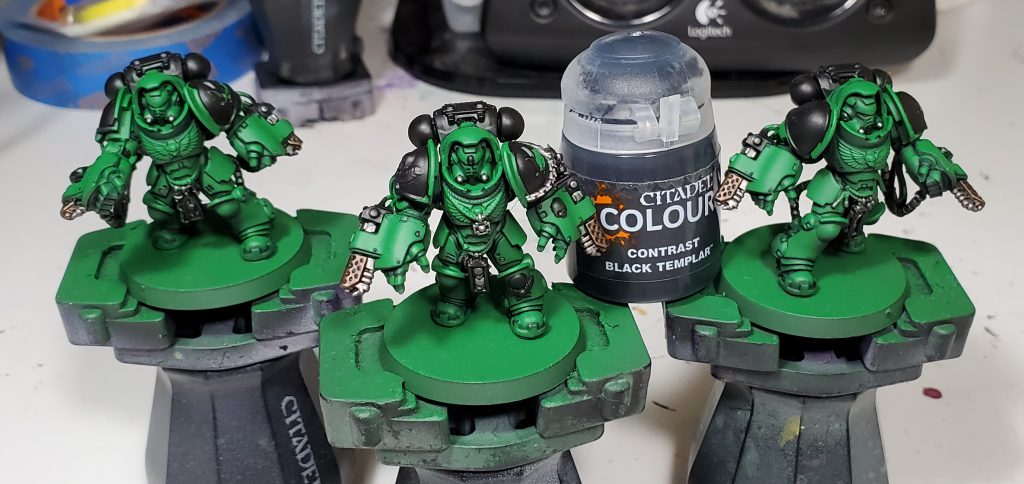
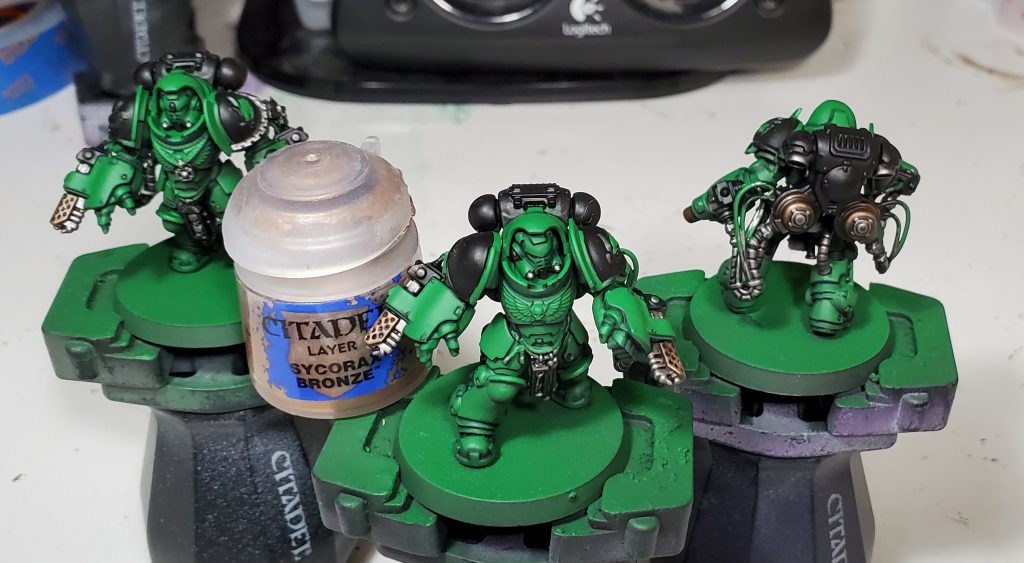
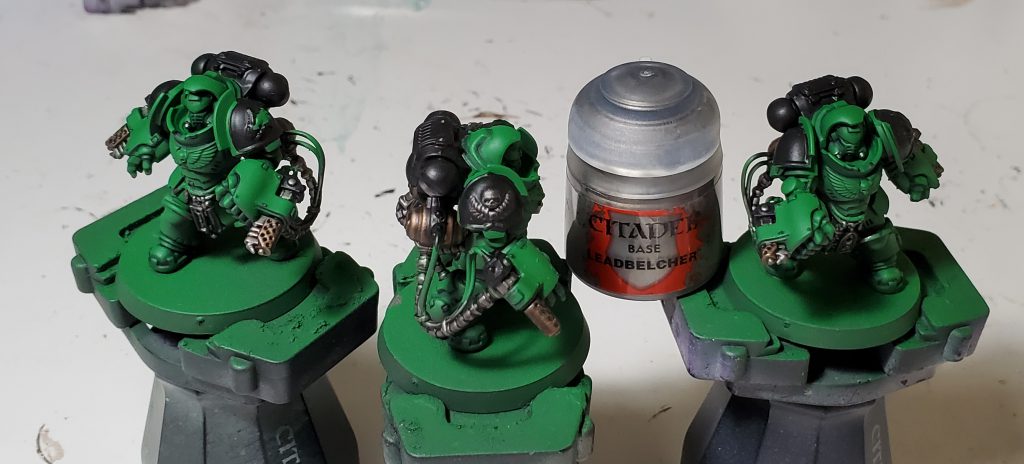
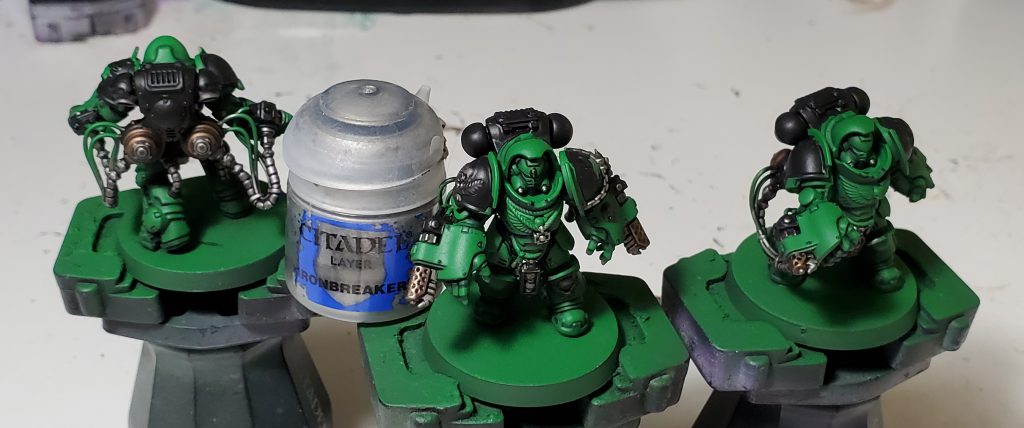
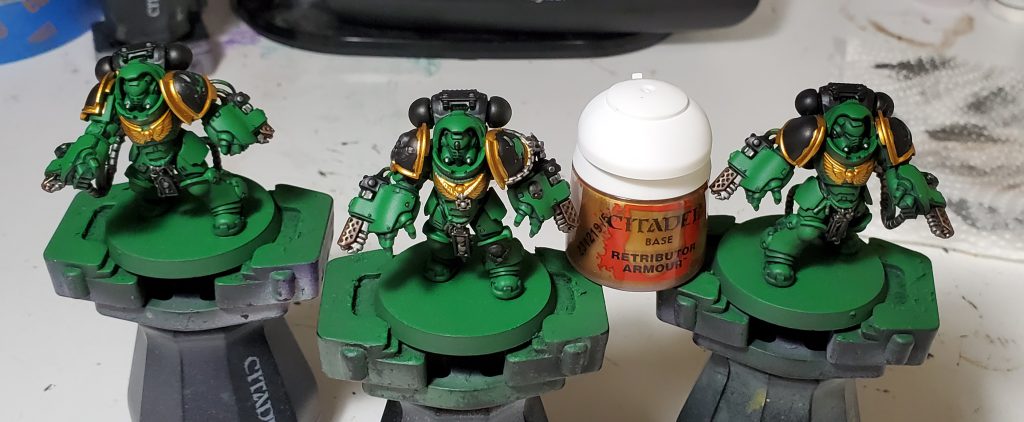
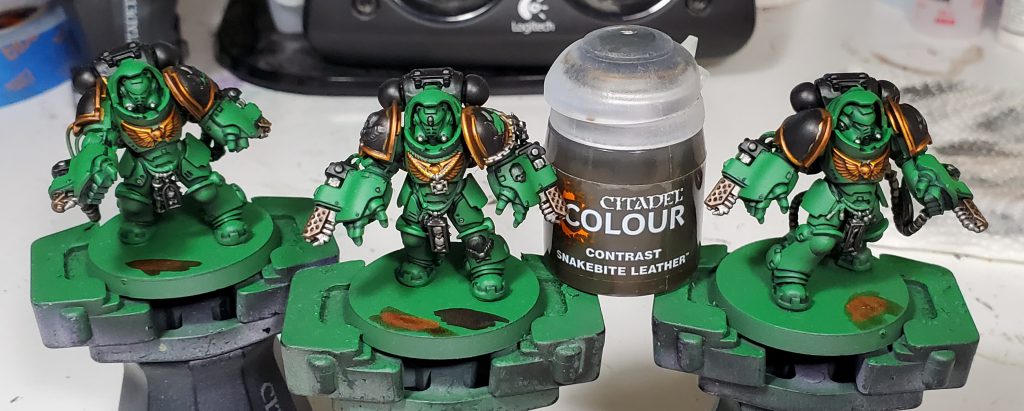
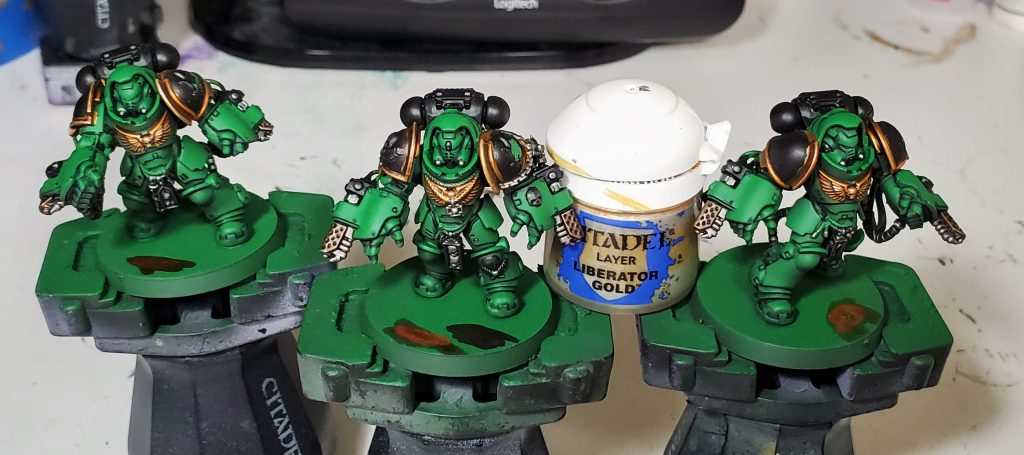
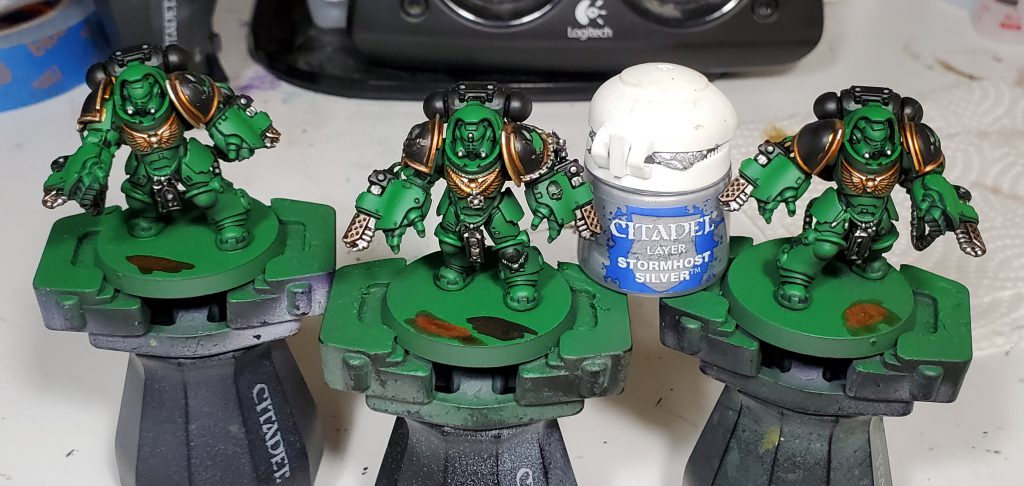
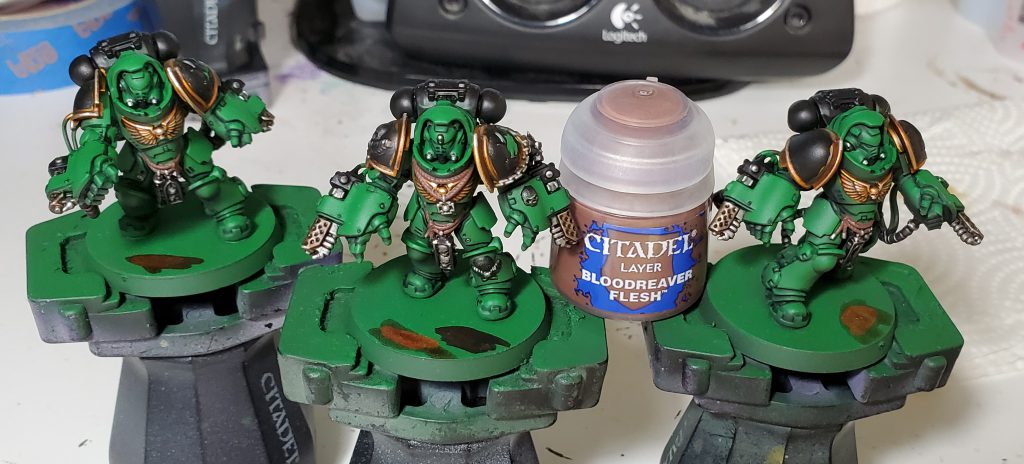
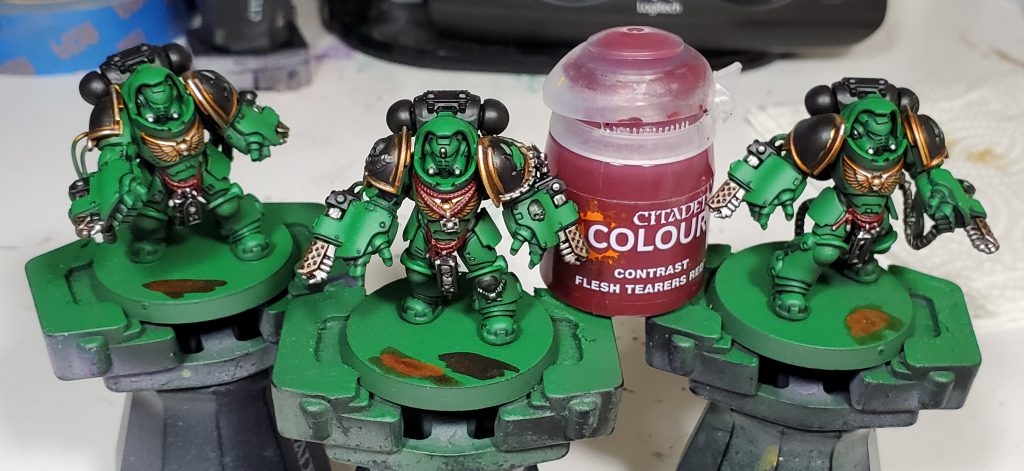
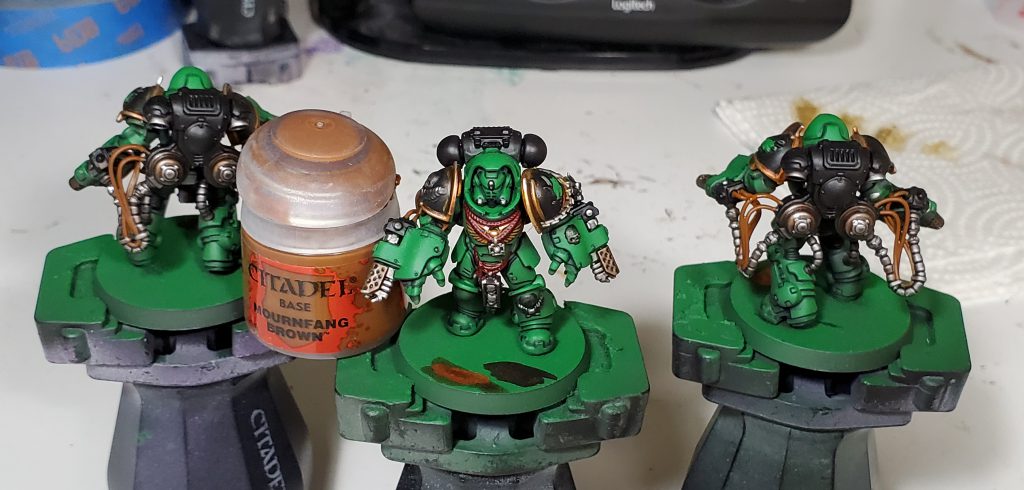
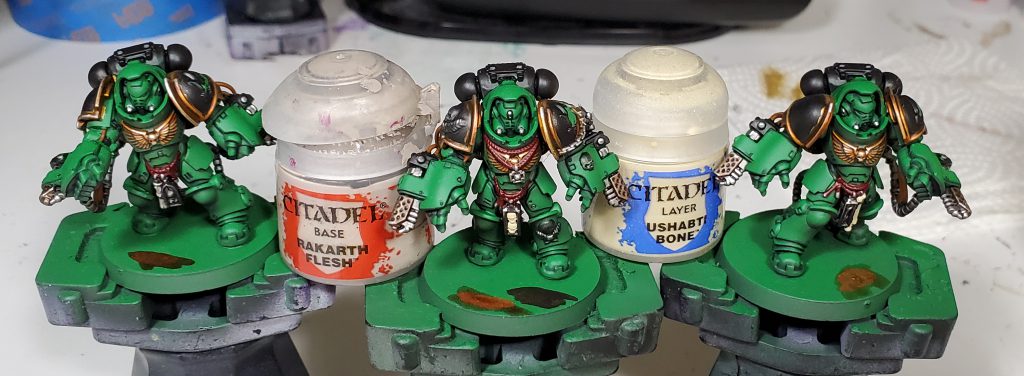
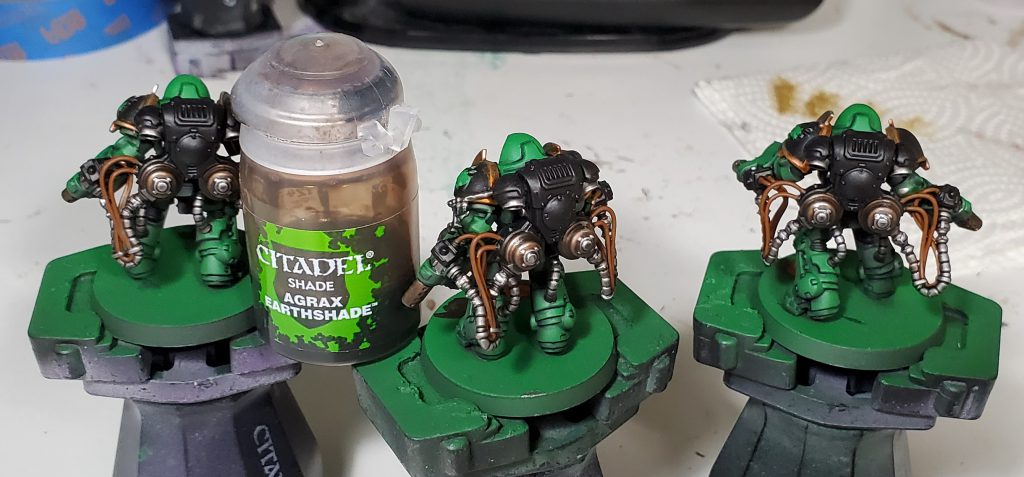
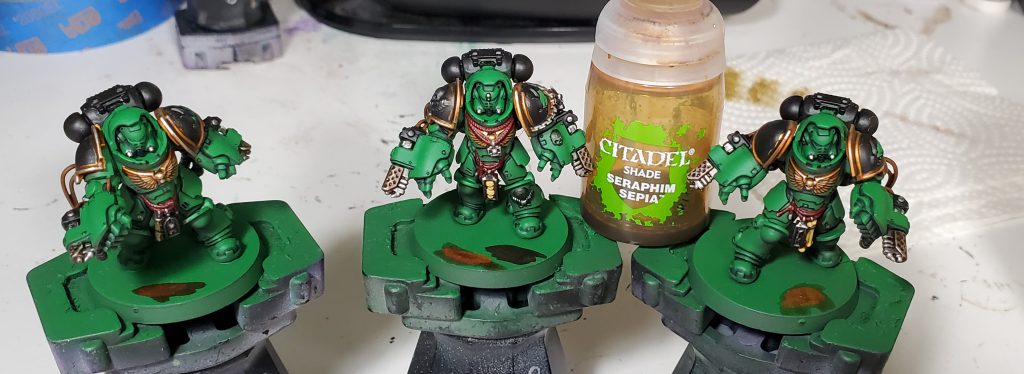
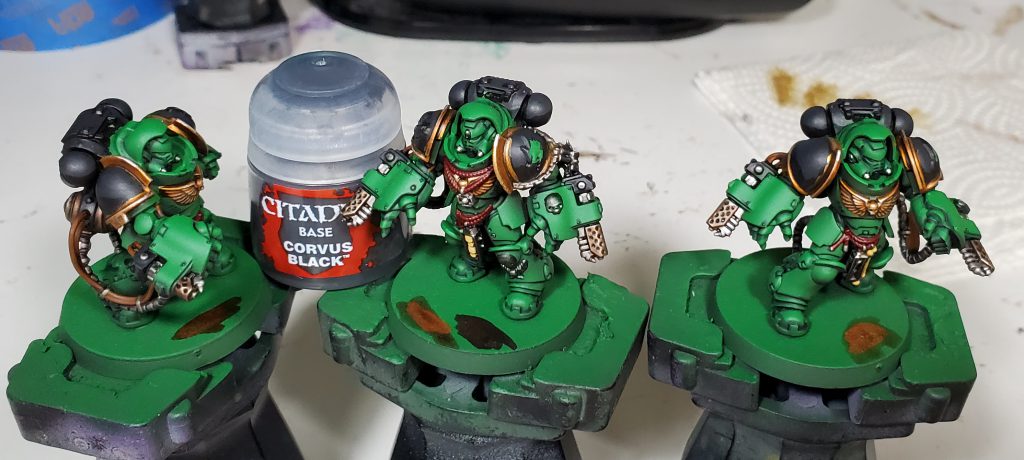
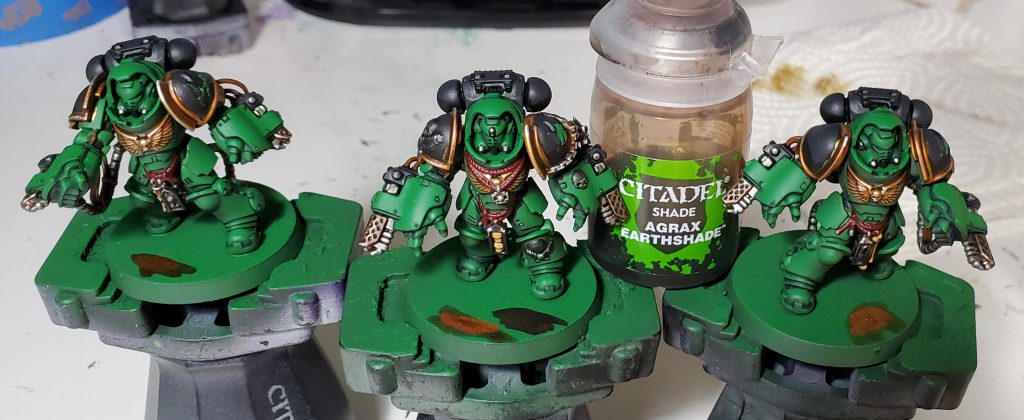
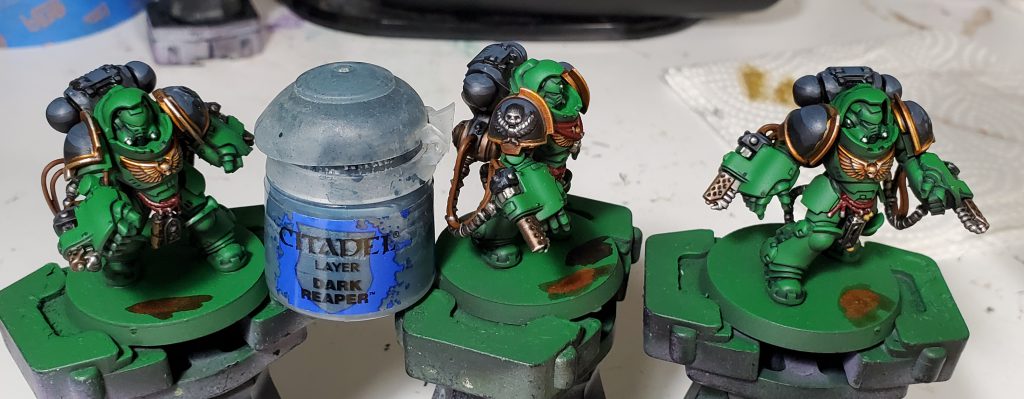
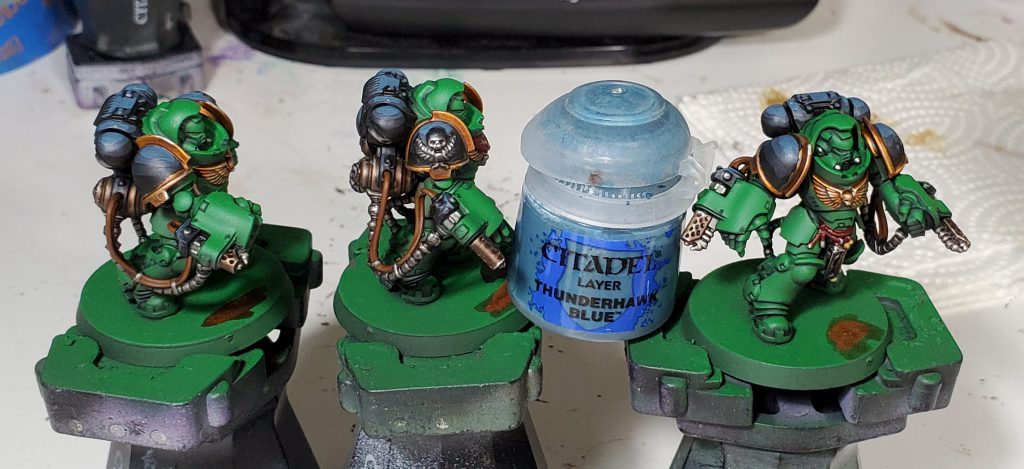
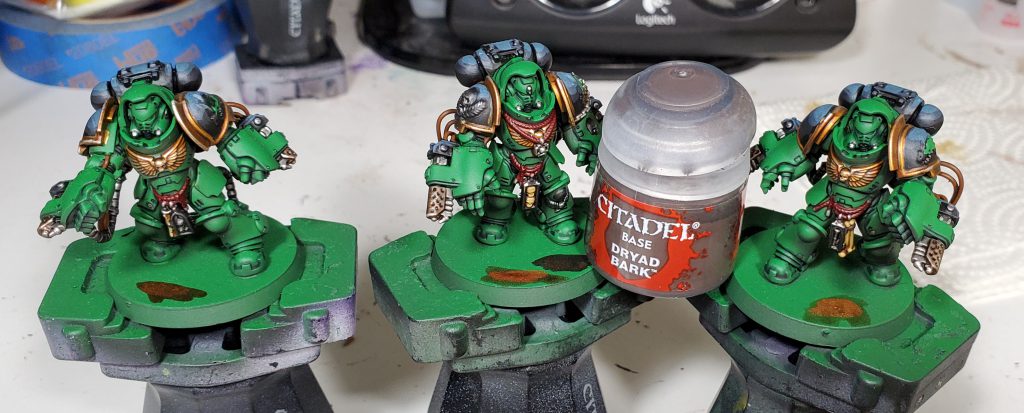

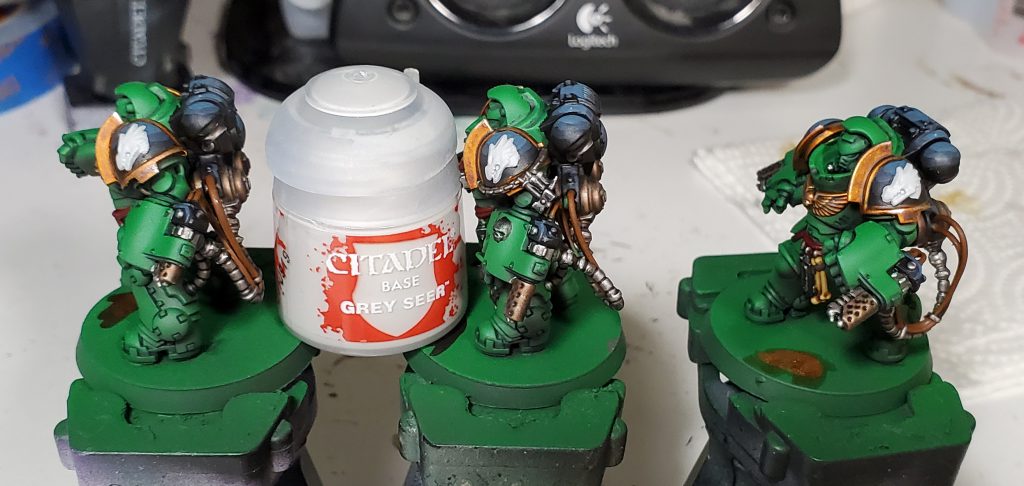
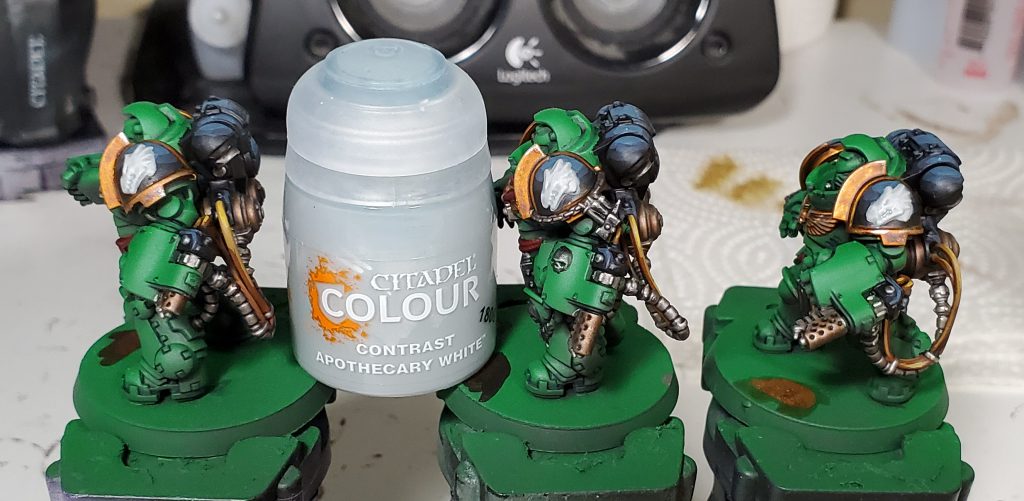
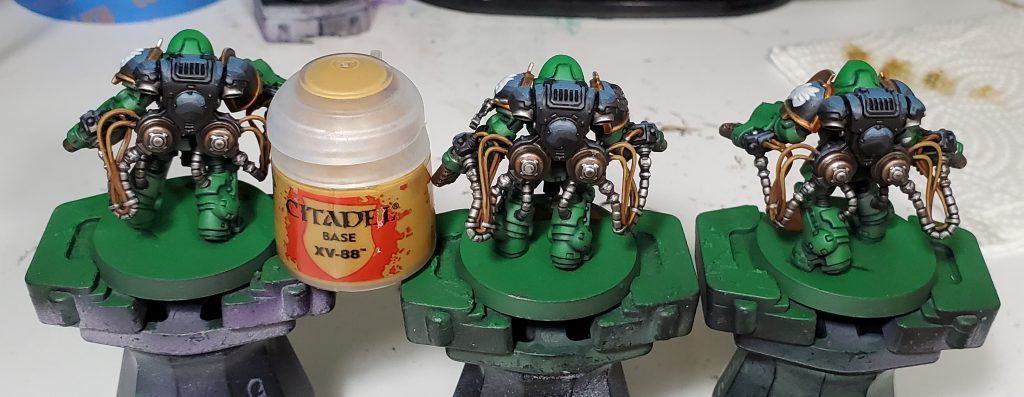
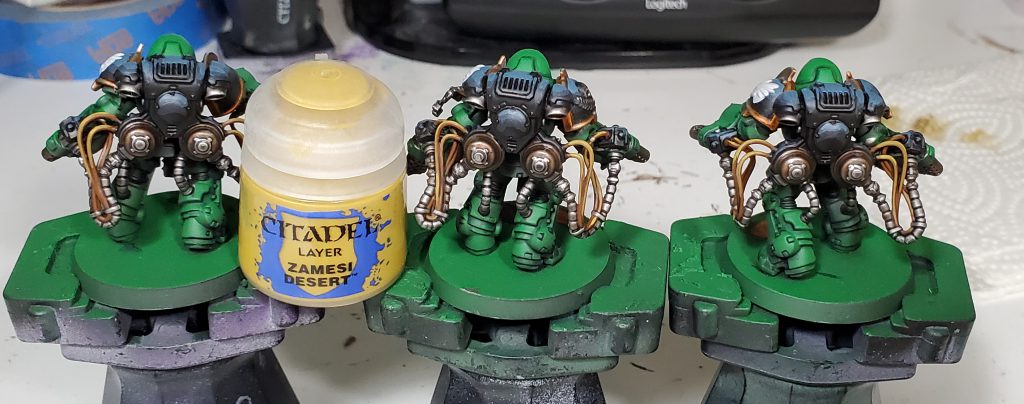
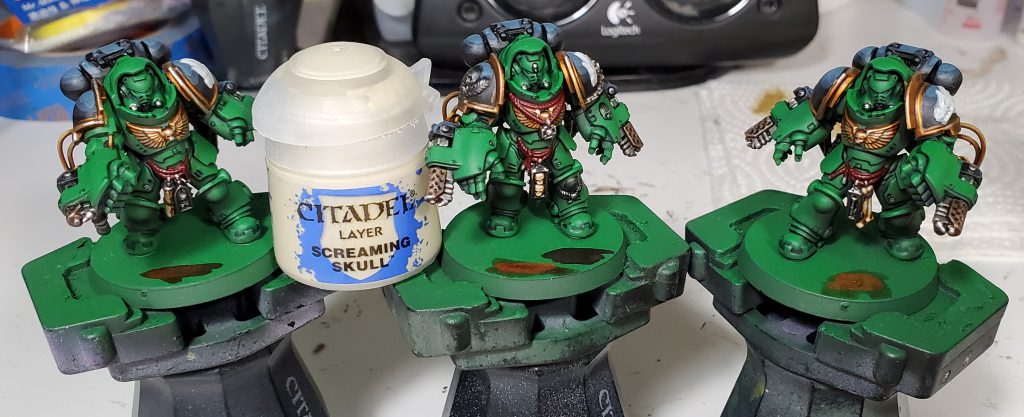
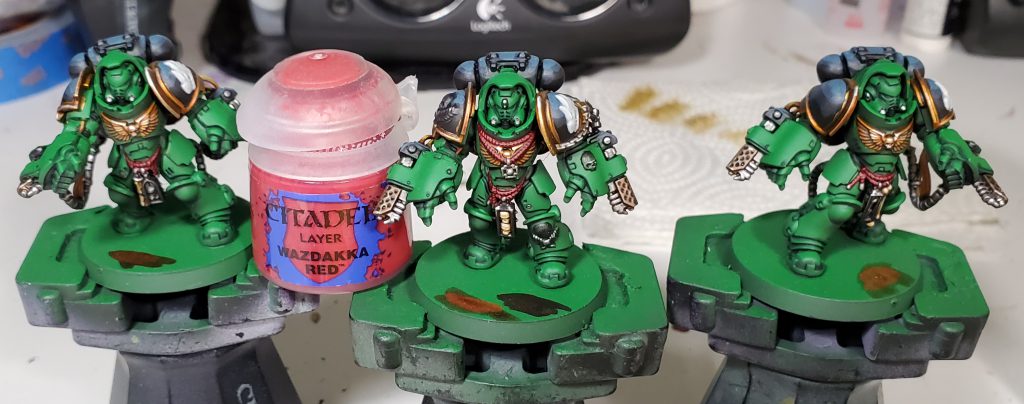
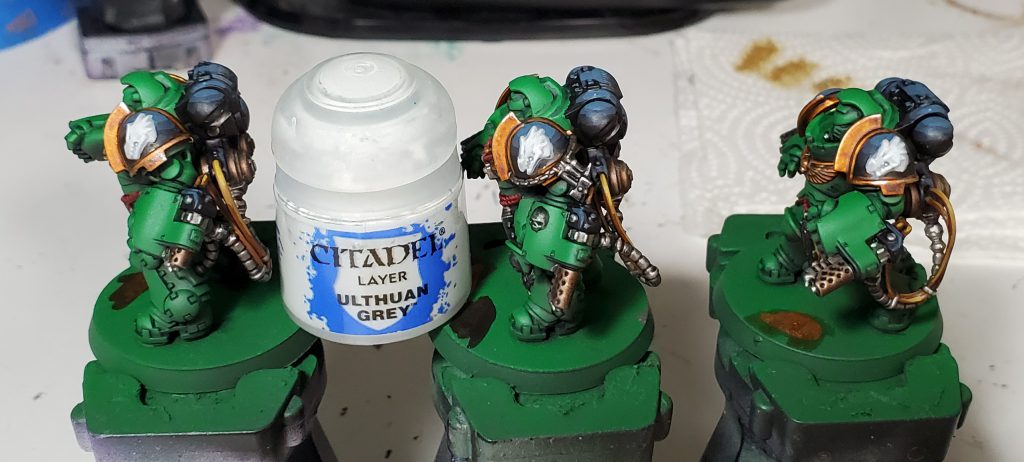
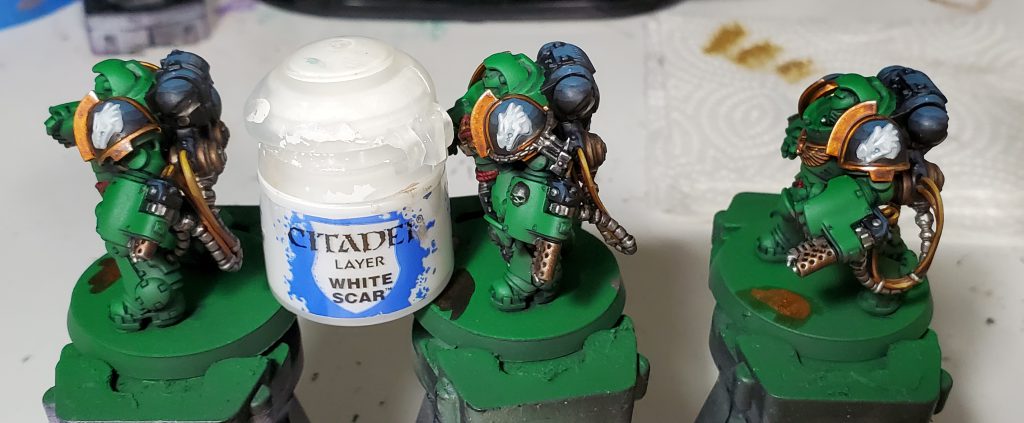



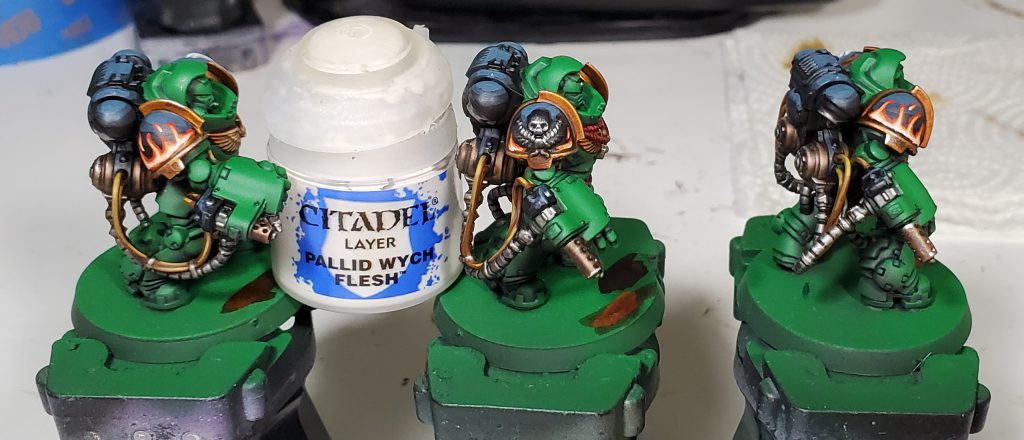
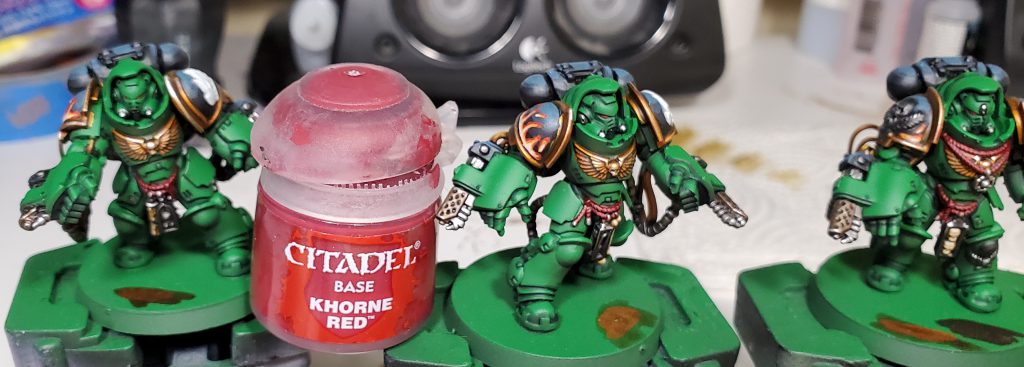
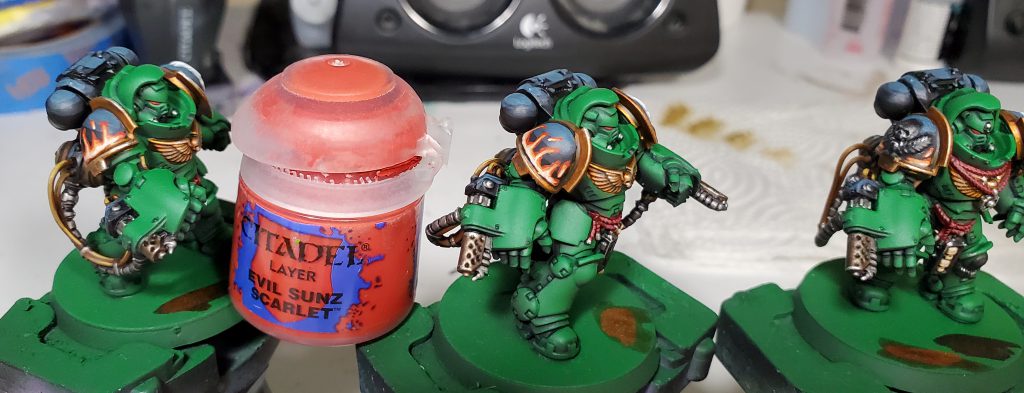
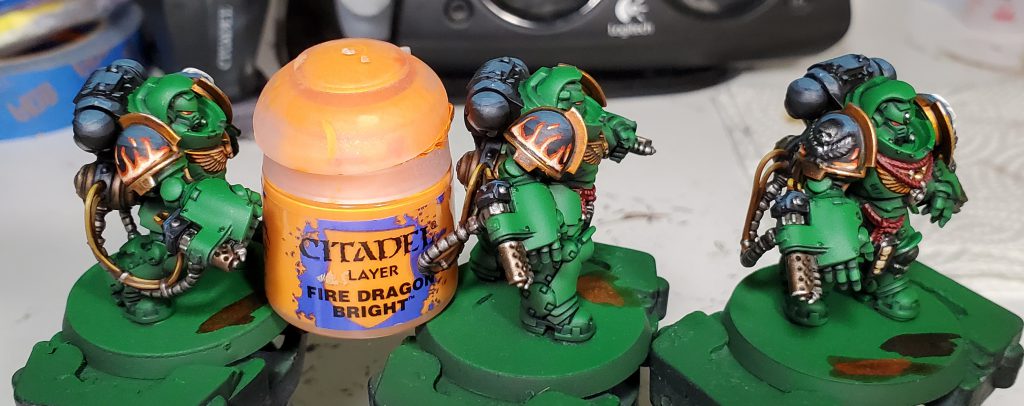
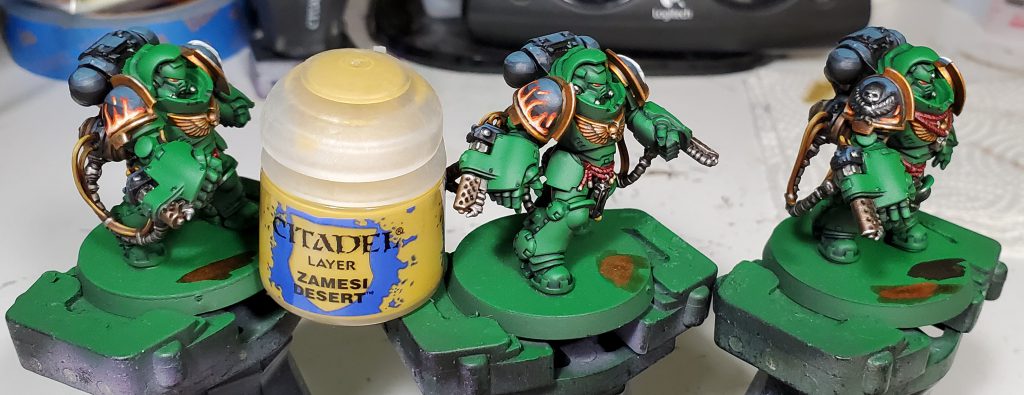
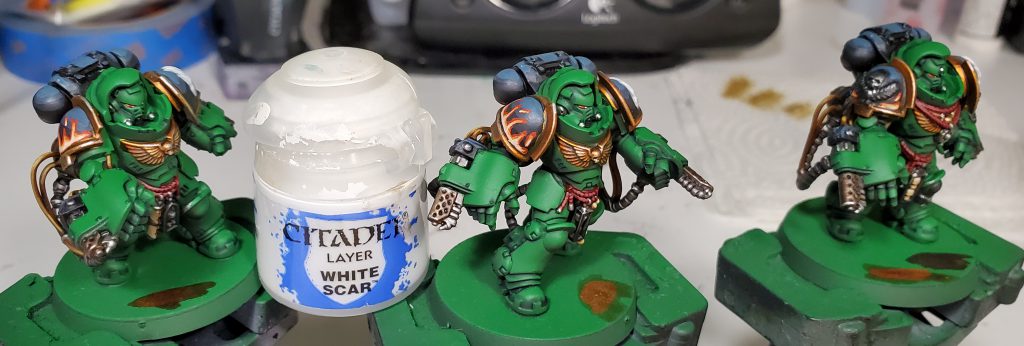
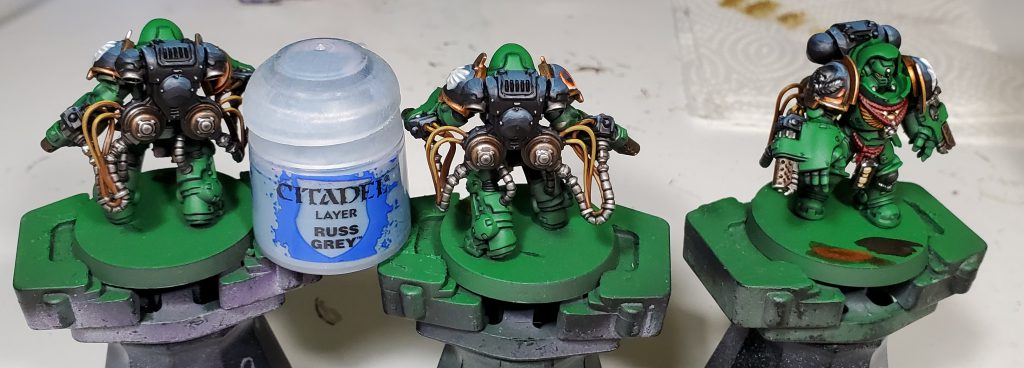
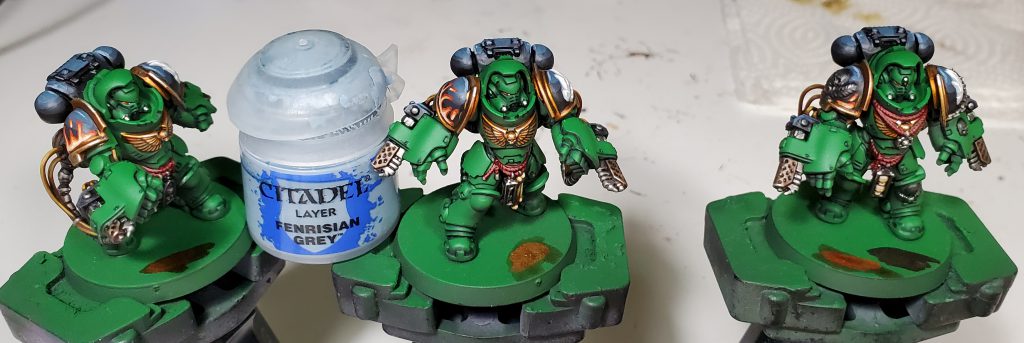
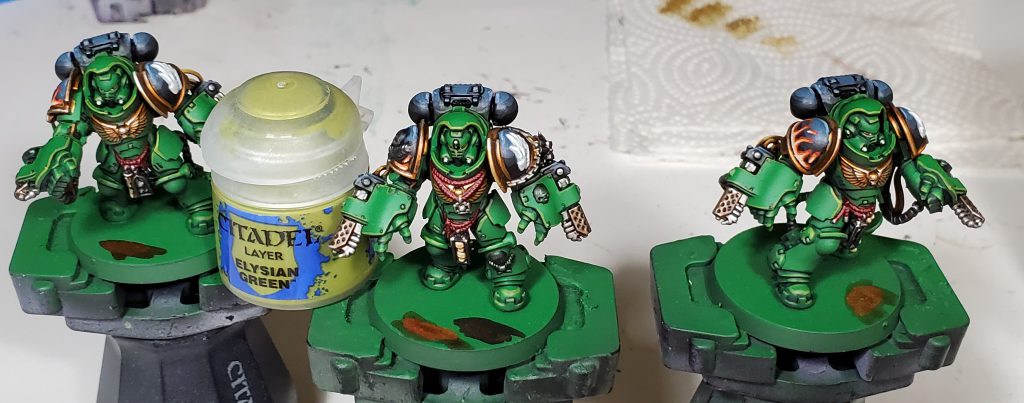
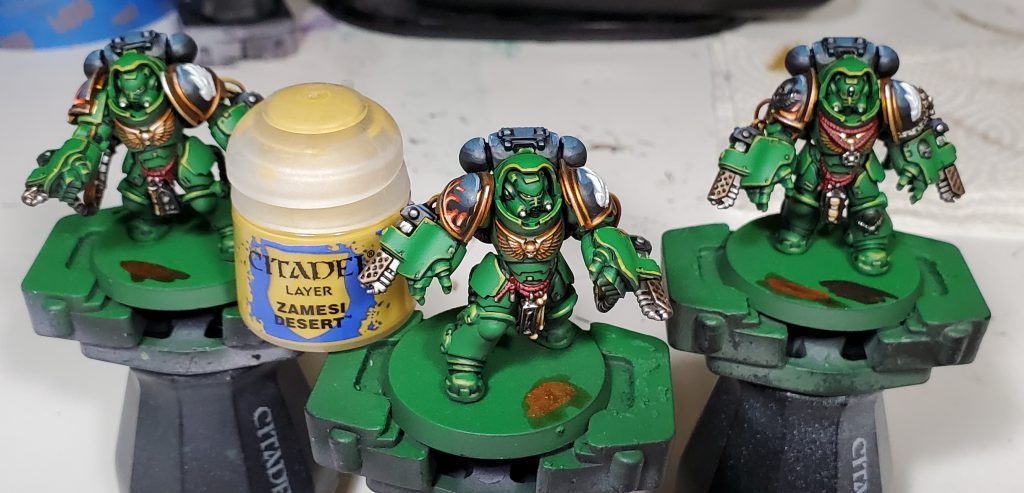
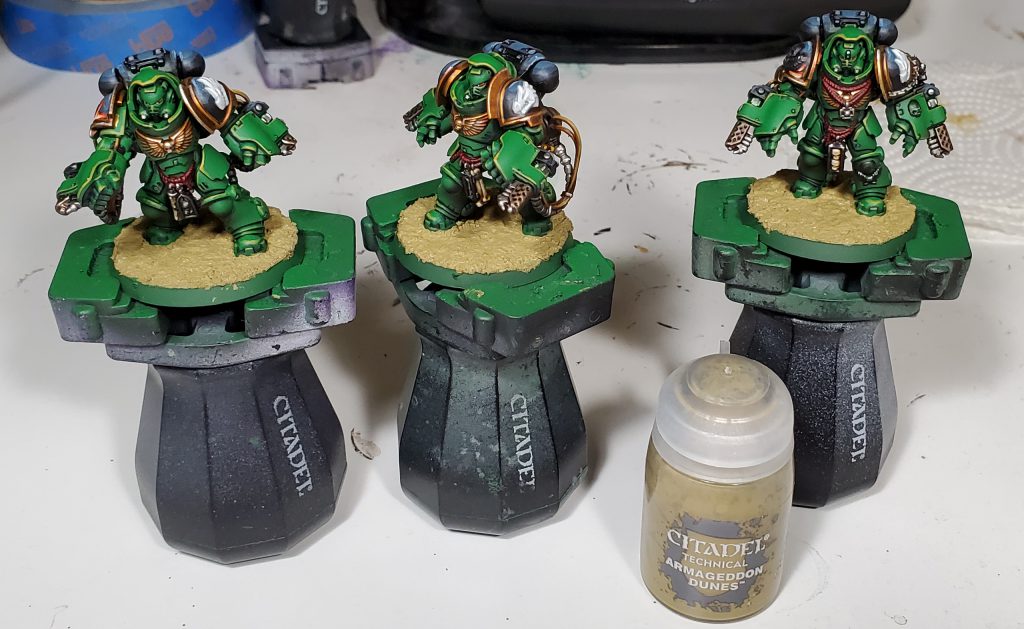
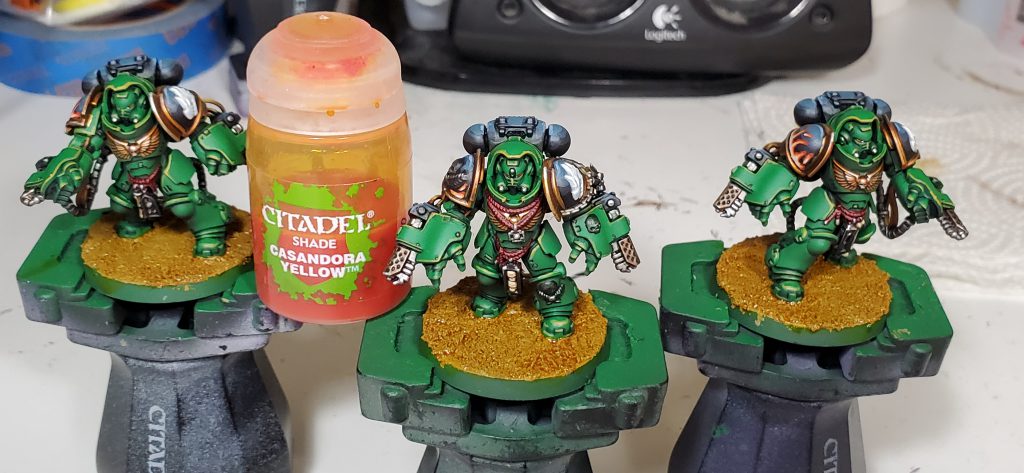
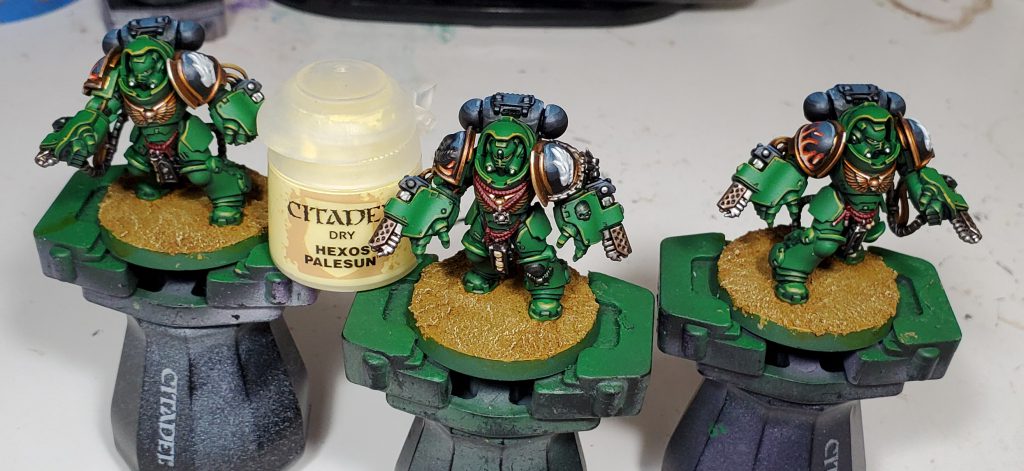

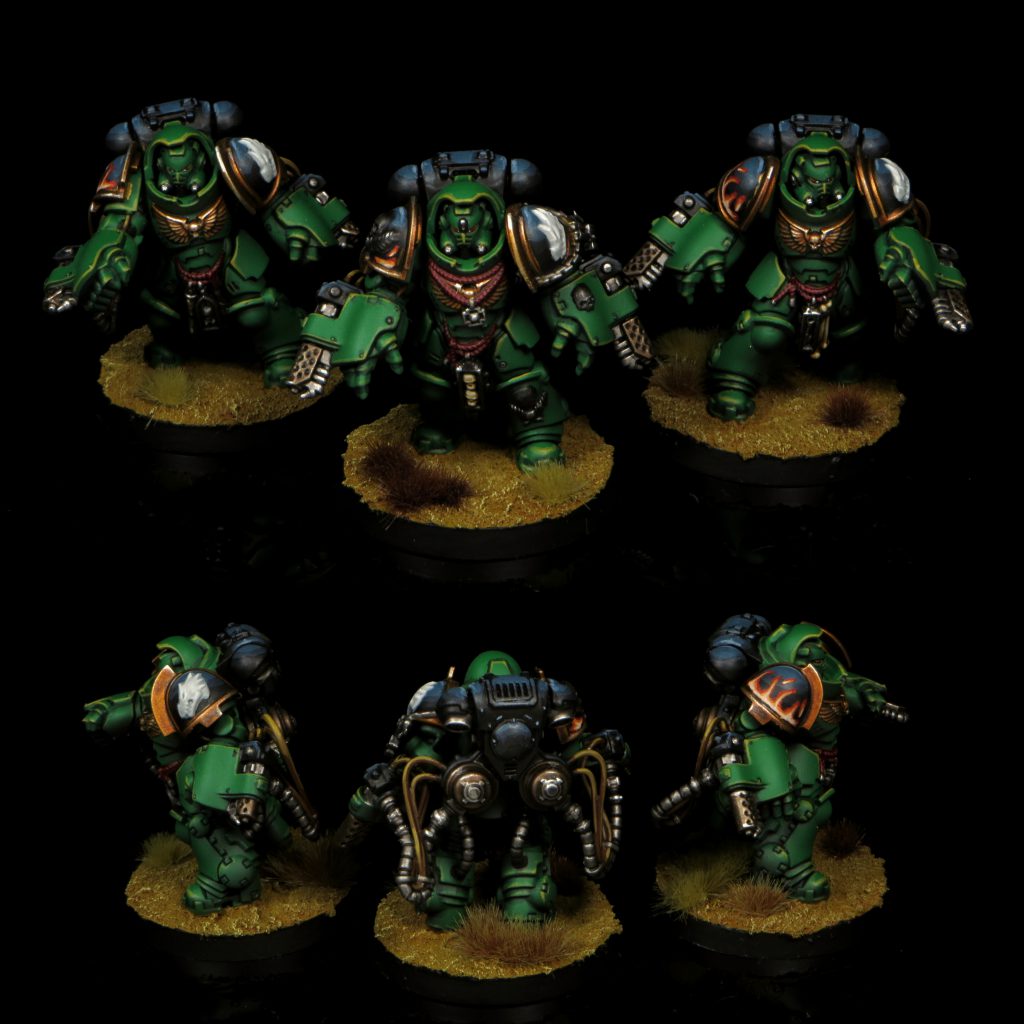
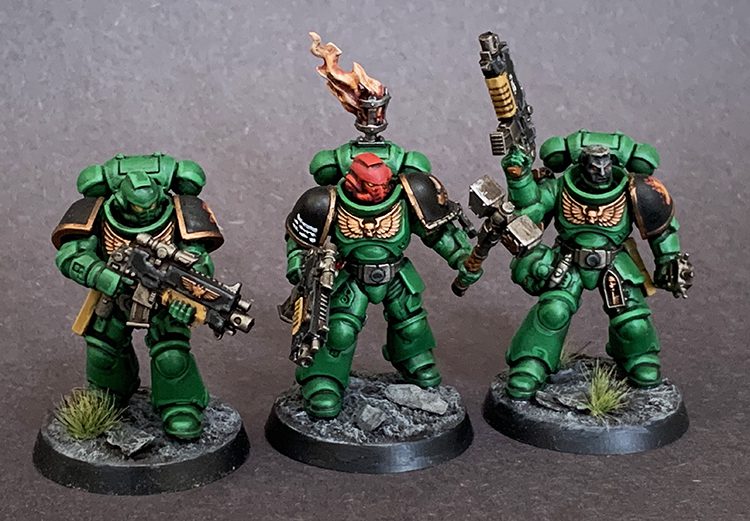
The Armor

The Skin
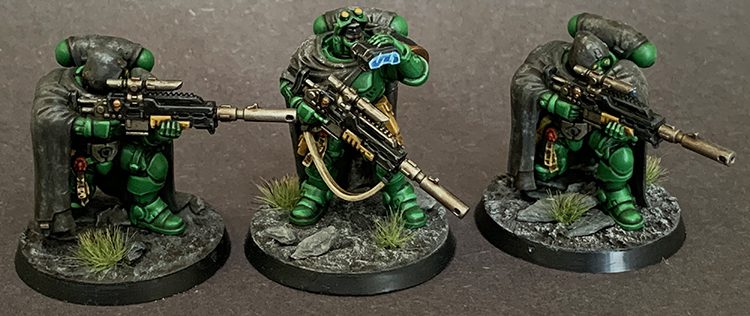
Pockets/grips
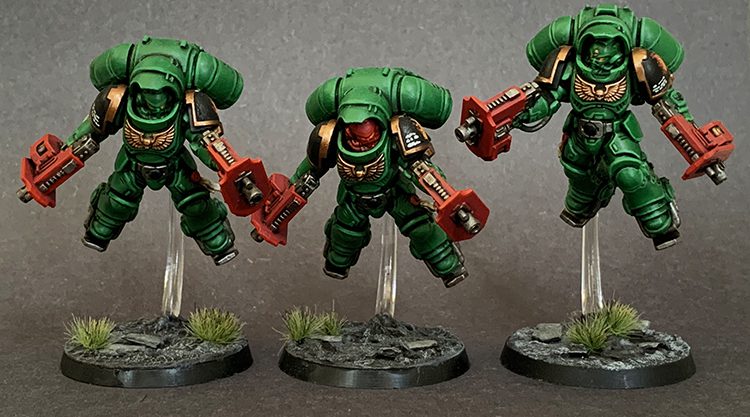
Phobos cloaks
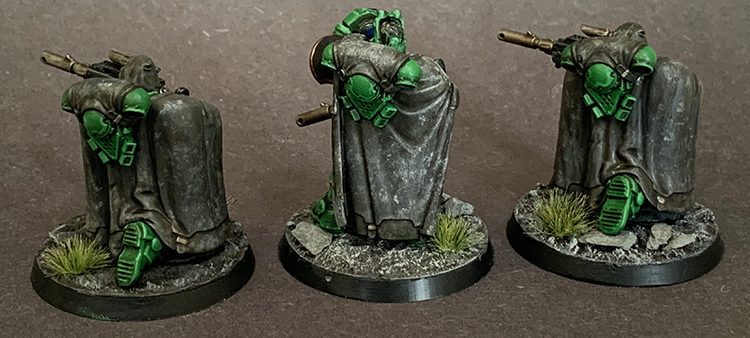
Bolt weapons

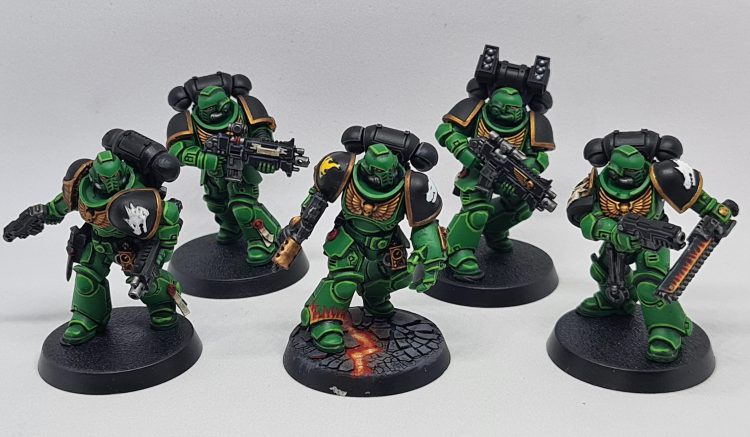
Subassemblies
Armour
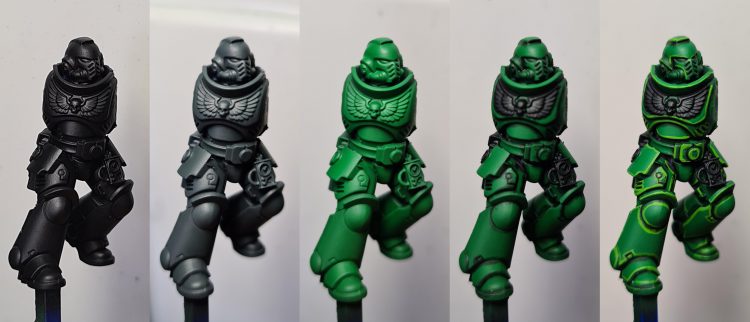
Gold / Trim / Gizmos / Metallics
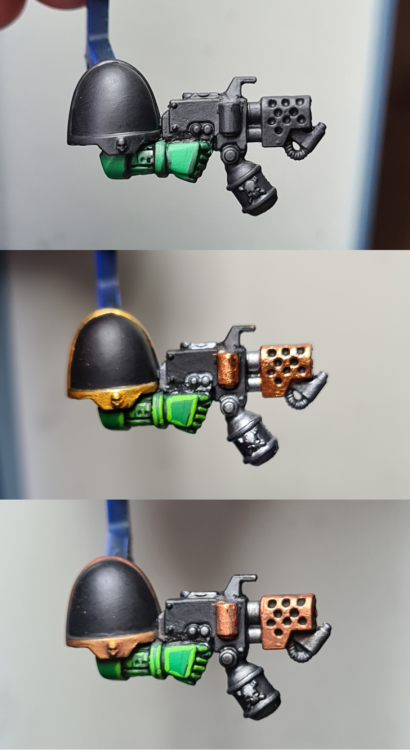
Skin
Flames

Backpack
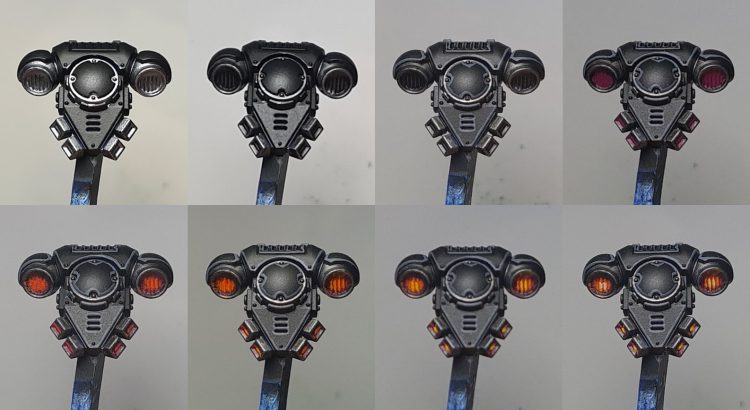
Eye Lenses
